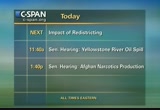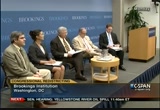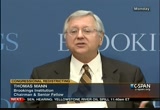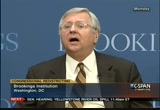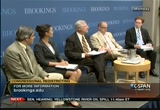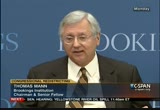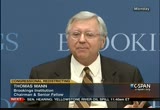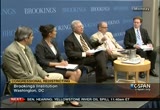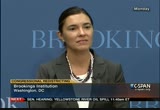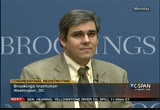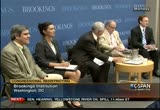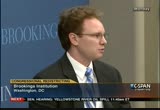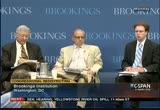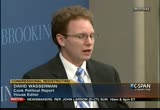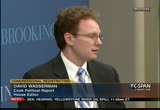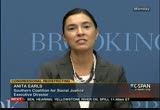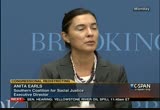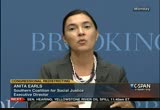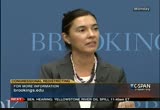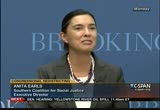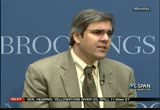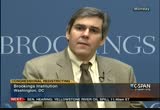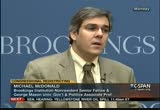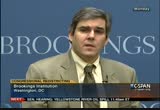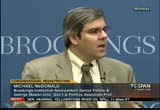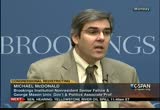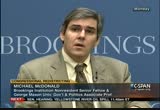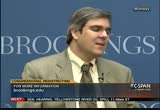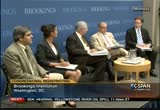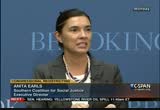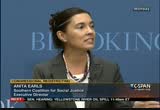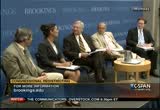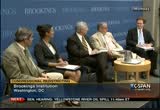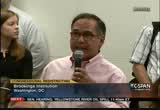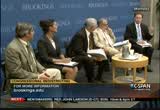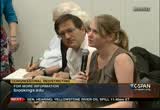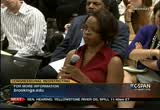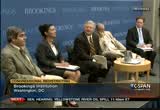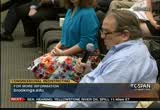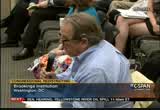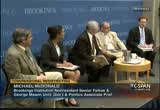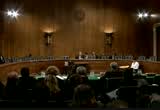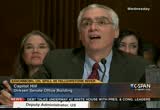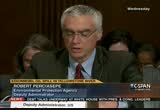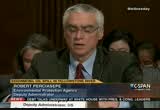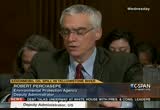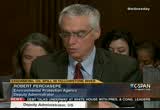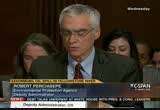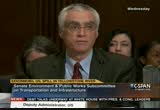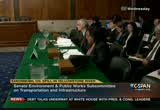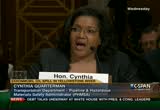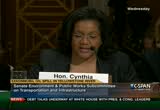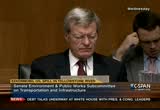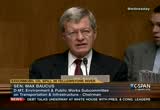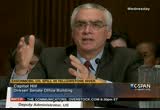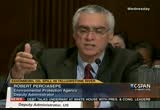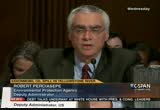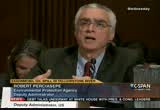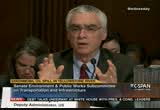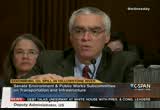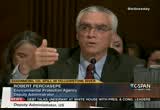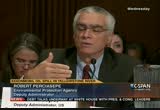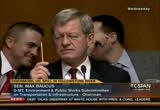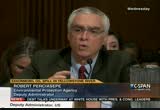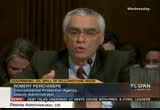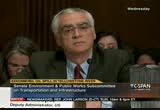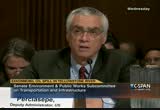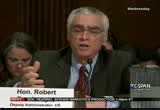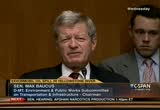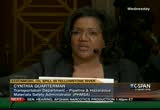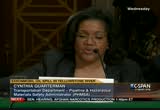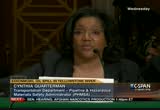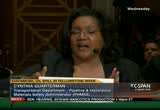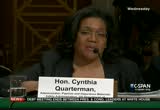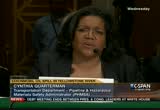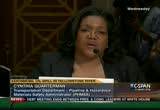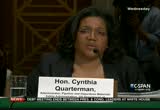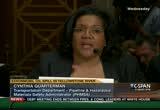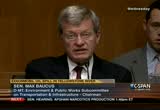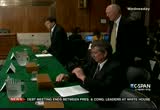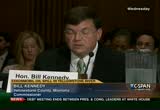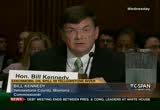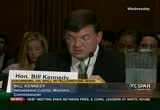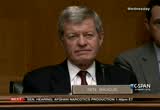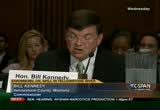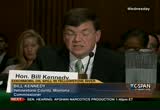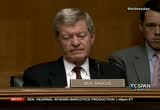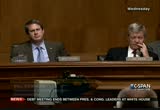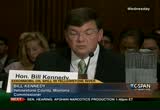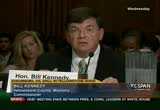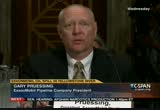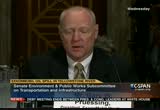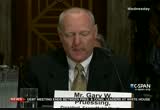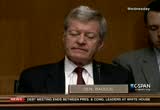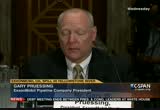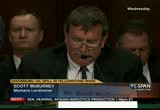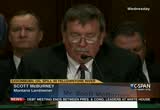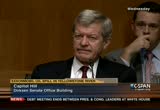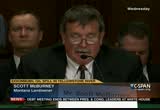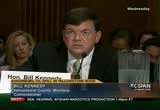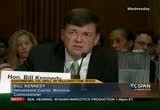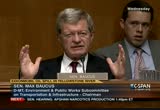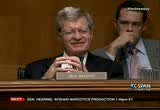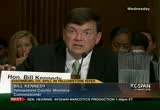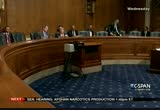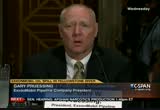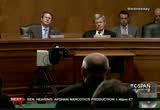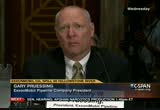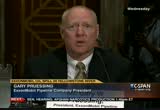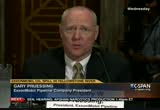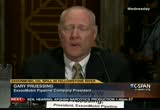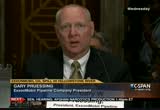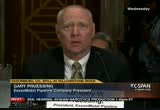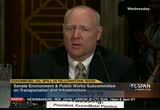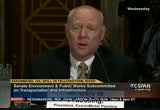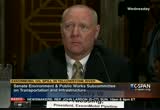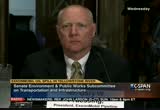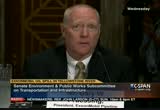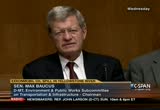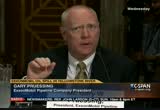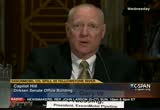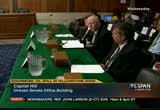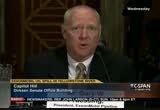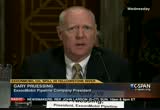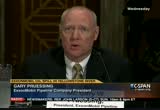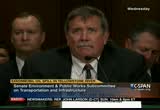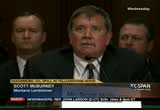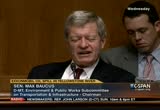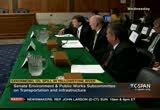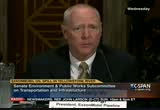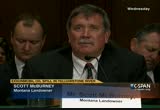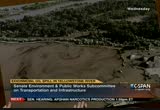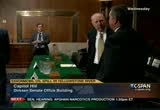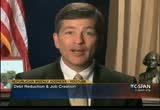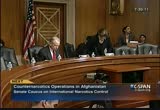tv C-SPAN Weekend CSPAN July 23, 2011 10:00am-2:00pm EDT
10:00 am
>> host: meredith mcghee of the campaign legal center, she serves as their policy director. thank you very much. >> guest: thank you for having me, i always enjoy it. >> host: don't forget on espn3 this weekend, it's american history tv and especially on sunday a special program to mark the 150th anniversary of the battle of bull run. it will take place at the manassas national battlefield, you'll get a chance to hear from top historians and ask questions, too. that's part of our civil war coverage of 150 years, that's american history tv on espn3. you can see that from 11:00 to 4:00 tomorrow. for tomorrow's program on "washington journal" we'll continue following what's going on in the debt talks, jennifer ruben from "the washington post" will join us and jim gernstein, a pollster, he is the right turn blogger, conservative issues. j.j. messner will talk about the
10:01 am
failed state index for 2011, taking a look at what are known as failed states around the world and 9:15 we'll hear from jon jarvis, director of national park service. all that, your calls and phone calls, too, and a look at the papers, i'm "washington journal," it starts at 7:00. we'll see you then. national captioning institute] [captioning performed by national captioning institute] [captions copyright national cable satellite corp. 2011]
10:02 am
[captions copyright national cable satellite corp. 2011] a >> the bewitching hour has arrived. it's 10:00 a.m. i'm tom mann a senior fellow here at brookings, and i'm delighted to welcome all of you. with us here at brookings this morning and to our live espn audience to a -- c-span audience to a session entitled a status report on congressional
10:03 am
redistricting. now, you may have noticed on the screens redistricting d.i., wording why that's there. we understand some of you are compelled to tweet wherever you are, and if you do, we want you to know that is the event hash tag. i know you're shocked that i actually said that, norm, but there is it is. >> it was written down so you know. >> i'm a well-known tweeter. six months ago we had a session here, almost to the day, that was a preview of the redistricting session. today we're going to take stock of how that process is unfolding and with what consequences we can detect at least now. why do people pay so much attention to redistricting?
10:04 am
good question. first of all, it's a fascinating game. political junkies simply can't resist. we can start talking about it, the midterm election before and continue on for years after as we try to discern the consequences of it but much more personally, there are -- there are genuinely high stakes involved in redistricting. certainly it's relevant to party control of the house where democrats now need 24 additional seat gains to regain the majority. obviously, as it plays out in state legislatures and local governments it has a bearing on partisan control there as well. it's certainly important, as far
10:05 am
as minority representation, a substantial majority of the population gains since the last census have been among minorities. the question now is will those population gains be reflected in seats in the house and at other levels of office. finally, redistricting has some bearing, disputed to be sure, not dominant, of course, but nonetheless, important for competitiveness, for responsiveness, and for polarization. i think for all of these reasons one has to acknowledge the stakes of this process are unusually high. it's also important to reemphasize the fact that the
10:06 am
u.s. is truly an outlier in the democratic world when it comes to the political control of the administration of elections. we won't today talk about the fec or the eac. we won't be talking about new state laws on voter ids, early voting registration. all of those are caught up and shaped very much by the political and partisan struggles that exist in this country. instead, we'll be focusing on one aspect of that, namely, redistricting. i think it's also important this round because of some of the new initiatives that have been taken on redistricting process. perhaps the most interesting and visible is the switch to an independent citizens commission and in the state of california, which is unfolding as -- as we
10:07 am
speak. david rosserman, among others, has reminded us how little turnover there has been in the california u.s. house delegation over the last decade, when we had three truly dramatic electoral swings between the parties, it simply was -- the state of california was insulated from that process. the question becomes does that game change, now, florida passed a couple of initiatives that have tried to impose some discipline on that process. right now the swing state of florida has 19 republican members of the house and five democrats, as i recall. it may be the sharpest,
10:08 am
strongest partisan gerrymander in the country. will these new requirements approved by the initiative process have any bearing? we also have ongoing efforts to really increase the transparency of the redistricting process, and in particular, an effort to try to get citizens involved in map-making themselves. we fortunately have a wonderful panel to talk about all of these matters and others today. our plan this morning is to begin with initial presentations, then we'll have discussion among our panelists, and finally we'll take questions from all of you. i'm going to introduce our panelists in the order in which they will speak. we'll begin with david wasserman
10:09 am
who is down here to my left. david is the house editor of the "cook political report." he's responsible for handicapping and analyzing house districts. last year david wrote, authored, put together a volume called "better know a district," which is the bible for this round of redistricting. it's a wonderful piece of work, david. and we've all come to rely on it. david's got to get us off with an overview of where we stand, how the process is unfolding. then we're going to turn to my colleague immediately on my right, anita earls who is the founder and executive director of the southern coalition for social justice, a nonprofit organization in durham, north carolina. anita's been a civil rights
10:10 am
lawyer, she's been deeply involved in voting rights and in redistricting and she will speak on a topic of enormous interest, as i said, the population growth has been among minorities but it isn't yet clear that that growth will be reflected in seats. she will give us an overview of how that's playing out in a number of states and how quickly we have or will be moving into the courts on that process. we'll then turn to michael mcdonnell who is a nonresident senior fellow here at brookings, associate professor of political science at george mason university. someone who has been a consultant to redistricting authorities, including the arizona redistricting commission, who has launched,
10:11 am
through brookings and a.i. as well the public mapping project and will tell us of the efforts to really increase public participation and -- and transparency in this entire process. we'll then end with my colleague, norm ornstein, a rest skyler at aei, everyone knows appropriately, norm is going to tell us after hearing from our other three colleagues, what it all means for politics and policy. so that's the game plan. david, kick us off. >> thank you very much, tom. thank you to brookings for giving so much love to an often underloved topic but i often call redistricting a once in a decade nerdfest for politicians,
10:12 am
pundits, academics, lawyers, carttographers, you name it, i'm pleased to see so many nerds out in the audience, i definitely am one, god knows. redistricting is really only one of the arenas if not the only arena in which it's fair to compare lebron james and dennis kucinich. i really don't think if dennis kucinich will do any better in terms of winning but i really think that examples of how redistricting affects our politics are everywhere around us. even if they're not necessarily part of the news articles that we read on major issues at stake these days. during the medicare fight, for example, i don't think last year any of us could have predicted that paul ryan or the state of wisconsin would generate so much attention in coverage this year in terms of the fiscal woes facing the state and paul ryan's budget. and i think a lot of the attention on his district has been misplaced because democrats
10:13 am
are saying, well, we've got this candidate, rob zerban who is kenosha county supervisor, and a lot of pundits, a lot of people you talk to in the consulting world, very few of them who are credible would give him a chance of really taking it to paul ryan. but i do find significance in his district and that if you plot out all 435 house seats on a scale of the most republican districts, the most democratic districts in the country, on our scale of the partisan voting index of the cook report, guess which one is the 218th district, the fulcrum of the house? it's paul ryan's district. for me it's the perfect illustration of why it's going to be so difficult for democrats to get to that magic number of 218 in the house. not only because of his personal appeal but because these recall -- but before these recall elections in wisconsin, republicans are trying to engineer a plan to make his
10:14 am
seats in addition to a couple points republican. it's moving goal post. another goalpost moving right now is the ability of republican leaders in the house to corral a lot of their members to get behind any kind of deal on the debt ceiling. now, how does redistricting factor into this equation? well, it's not as difficult to pass any kind of package, thanks to the line in the sand drawn by 60 members of the tea party caucus in the house, that's only one out of every four republicans in the house. but if you take a look at what's happening in redistricting just about everyone's going to have to take on new voters. and that means that we have a whole slew of republican incumbents in the house beyond just those in the tea party caucus who are affected by i can taking on new voters and looking over their shoulders for a potential primary challenge. and i think that is really making it more difficult for anyone to break from a hard-line on that subject. but today's subject is a status
10:15 am
report on congressional redistricting. we're done in 10 states which means we have 33 to go, seven states don't need to redistrict because they only have one district. and if we're keeping score of which party is more likely to gain or lose seats in certain states where the writing is basically on the wall by this point, even though only 10 have completed congressional redistricting we can really say a lot more about what's likely to happen in the rest of the states that have kind of shown their hand thus far democrats are likely to pick up a seat or republicans are likely to lose a seat in louisiana, maryland, nevada, washington. republicans are likely to gain a seat or democrats are likely to lose a seat in georgia, indiana, massachusetts, michigan, missouri, pennsylvania, south carolina, utah, and i'm leaving out north carolina and illinois because those are kind of the big jackpot states that are
10:16 am
really driving each party's potential for gain. and then i have a question mark as far as which party's going to gape or lose a site, it could be a fair fight in states like iowa, new jersey and arizona. but i'm sure the five states we'll be talking a lot about this morning and i'll stop short from going in-depth on them are illinois, north carolina, which are both parties' opportunities for partisan capitalization on this redistricting, illinois for democrats, picking up, you know, potentially five or six seats, or four or five seats, republicans losing five or six in illinois, north carolina where i put republican gains at possibly three seats depending on the legal challenge to the map that republicans are proposing, and then california, where i think democrats, at the end of the day, will probably pick up two or three seats as a result of the untangling of california's uncompetitive lines at the moment. texas, where, you know, i expect it to either be a draw or republicans netting two seats
10:17 am
depending on the legal challenges that we'll be talking about and then the big wild card being florida. and i'm sure we'll make that a big part of our discussion. but there are really two ways to measure how redistricting affects the big picture in the house. you can look at it in terms of the score card that i just went over which seat, if you add up all of those columns, is going to end up ahead at the end of the day. well, i think it's going to be very, very close to a wash, depending on florida, i think it's possible democrats could pick up a handful from the process which is surprising given that republicans earned so many state legislative chambers and picked up so much control in 2010. but then the other side of the equation is really how much can republicans shore up the gains that they made in 2010. and that's a part of the equation that's been more difficult for a lot of us in the pundit world to quantify. but one measurement that was kind of suggested at
10:18 am
realpolitics.com and i appreciate this a lot more than a lot of other metrics that have been thrown identity is make the median seat in the house and how far to the right does it move as a result of republicans in pennsylvania and ohio and michigan -- where they have control, shoring up a lot of the gains that they already made in 2010. i think the answer is that, on balance, that 218th seat in the house, that seat that democrats would need to win on average to pick up the majority in the house will move two points to the right of where it is today. maybe from a district that's two points more republican in the national average to a district that's four points more republican than the national average. and probably will one or two points wider as well because the trend we're seeing in so many states is for underpopulated minority districts to expand into the suburbs and rob a lot of very competitive, suburban seats of the democratic voters that make them competitive or have made them competitive in
10:19 am
the last few years but at the end of the day candidates and campaigns still matter and that's even after this process is completed, even after we have these new district lines there are going to be plenty of unintended consequences for us to talk about more than a year and a half from now. so i look forward to hearing what others have to say. >> terrific, david. thank you for getting us off to such a good start. anita. >> well, thank you, and good morning. i'm really honored to be here. i want to thank the brookings institution for inviting me and giving me an opportunity to talk about what i've been focusing on through the redistricting process is what is the impact on minority communities. and so i want to talk a little bit about that, talk about the legal standards are playing a role but also say a quick word about about the impact of technology that we're seeing and community involvement. but to start with, how it's shaping up so far for the interest of minority voters is
10:20 am
very important to consider latino populations and they're looking differently than what's happening with african-american population. i think across the country it's fair to say that there are real concerns about the fact that the huge growth in the latino population is not being reflected in the states where there are new congressional districts being drawn and those populations feel that their voting strength is not being fairly reflected in those maps that have been proposed and drawn. so in texas the several other latino organizations have filed suit. last count there were five cases in state court and seven in federal court already filed challenging how the congressional districts have been drawn. some of those claims are based on the fact that the increase in latino population in that state wasn't reflected in the maps that were passed. similarly, the plans that have been put forward in california,
10:21 am
you may have read in the news, the had he had of malao talking about extreme frustration and disappointment that those maps are actually hurting latino districts and not reflecting the strengths in that state. so i think that -- i mean, so with the latino population i think it's fair to say that they are very concerned and ready to go to court because the plans that are passed are not reflecting their voting strength. with the african-american population i think this situation is a little different. their growth is not across the board as great in the states. and they also, i think possibly, to a larger degree, have a little more history of having majority-minority districts drawn and being able to elect candidates of their choice. so there it's harder to say nationally what's happening. a lot depends on what -- whether they're in a state that's gaining or losing districts, which party's in control in that state and how the voting rights act works in that state so we
10:22 am
have states that are covered by parts of the voting rights act and states that are not covered. i will give two examples, though, that show some of the nuances when you're looking at the impact of the voting rights act and this round of redistricting and let me talk about north carolina for a minute. because the first congressional maps that were proposed by our republican controlled legislature in north carolina actually increased the minority percentage in both of the states' two congressional districts. and throughout the state african-american leaders were unhappy about that. and the reason is because they felt that that was actually draining their influence from other congressional districts in the state. and so where they had a history of being able to elect a candidate of choice in a district that was 42% african american, they don't want that district to be packed. what they would call packed into a 50% black district. i think, an interesting contrast is with the situation with latino voters in nevada where
10:23 am
there's a question of whether or not they're going to make this trade-off between being a majority in a single district or having a greater influence in more than one district. but i wanted to say a word about technology. as we're looking at this process unfolding, i expect that technology will make it easier to help folks draw maps but i think it's making it easier for public involvement in a lot of different ways. i never thought you could tweet about redistricting, apparently you can. you can sum it up. but also all the websites, they not only give you the opportunity to draw maps, but to really get a lot of information about the process and to stay up to date very easily about what's happening. in north carolina they did this process of having simultaneous public hearings throughout the state. so for the first time you could get a one -- go to one location and hear from citizens, i think they had six or seven different videoconference sites. and those are very long public
10:24 am
hearings, 3:00 to 9:00 in the evening but they were using technology to facilitate and increase public involvement. my third point is about public input. there i would say what i'm seeing is that is what is most impactful is where you have groups coming together and trying to draw unity plans or coalesce behind a plan that simply having individuals submit something in the legislative process is not as much of a check on some of the excesses as when you have nonprofit organization and groups coming together behind a single plan and really working through the process. so that's something i've seen this time that i haven't seen before. >> thank you, anita. michael? >> my name's michael, i'm a recovering jerry mannerrer. i've been involved in redistricting since the late 1980s. and it's been a -- i've been a redistricting consultant now in nine states. and on the experience of -- of being in the room and talking to
10:25 am
legislators about their districts and hearing a lot of gripes about what we were doing to their districts, let me realize that this is a very arcane process that the public is not engaged in. and really, at the time, in the '80s and '90s and last decade, really couldn't be involved in. because the decisions were being made using technology that cost a substantial amount of money, databases that were very difficult to use and just the technology then was an impediment to greater public participation within the process and also as a consequence of having restricted public participation less transparency as well so people couldn't really understand what the trade-offs were of different plans offered by state legislatures. and the media basically had to take as the -- say legislature's
10:26 am
word that that was the only plan that was feasible and there were no other alternatives that were available and we -- this is the way the world had to be. and so over the last decade, working with a partner of mine at harvard, michael haltman, tom norm through brookings, a wonderful advisory board of good government groups and bipartisan, by the way, as well, so people on both sides, both democrats and republicans, who see this process and know that it's not a good system that we have in place here. we moved forward in providing the technology to the public. now, something else that's changed over the last 10 years, and we're talking about tweeting and other things, is this -- the internet. the speed of the internet. the penetration of the internet. and so it's possible now to actually run redistricting software through web browsers. and that's what we've done. we've created software, it's
10:27 am
available on publicmapping.org. and it allows the public to draw their own redistricting plans. and we infuse the software with the data necessary to evaluate the plans that are being drawn as well so you can actually see what the political consequences are. that's a very complicated process because there's a lot of data to be managed and software and so it's -- still, there's a big hill to be climbed here. but we're trying to shoulder that burden as much as possible so that the public can be more engaged in this process. and so what have we done up to this point? we've supported redistricting competitions in virginia, michigan, those are concluded. there's one in arizona which is going to conclude this week. there's one in ohio which is going to start this week. and we're discussing potentially doing another competition in the
10:28 am
state of new york. so one of the ideas that we've had is let's get the public involved and offer prizes to the best districts that people can draw. have a panel of judges and, again, tom and norm were very gracious in agreeing to be the judges for virginia. competition. so that's one of the ideas. so at a very high level we could have a competition and, again, you have to have organization that's involved with that. another level you could just open up the process so that either individuals or groups would have the same software and data that the redistricting experts have. and we've been helping groups or individuals in states like massachusetts and new mexico, among other places, to draw maps and make some advocacy efforts based on the maps that they've been able to draw. so lower level would be the sort of just let's open up the process and allow the public to
10:29 am
draw some plans. what have we seen from this? well, we've seen that it's actually possible for people to draw a legal redistricting plan. at the outset, one of the crimes that we had even before we attempted this was to say you can't do this. people -- it's such a complex enterprise that it's not possible for somebody in the public to do it, only experts are -- have the ability and the skills to draw legal redistricting plans. well, i can tell you from our experience in michigan, the second-place congressional map in michigan was drawn by a 10-year-old. [laughter] >> and a lot of the editorial boards in the state of michigan said that 10-year-old did a much better job than the state legislature did in drawing congressional plans. it was more compact, more political fairness, more competitive districts, split more county boundaries so it didn't do as well on the county
10:30 am
boundarieses but it showed a 10-year-old can do this, in fact, that's what we found is that younger people really do engage in this. it's like a video game for political junkies to draw these redistricting plans. and in virginia we had -- it was more of a student competition led by faculty members across the state, we had 15 student teams at 13 of the state's colleges and universities draw redistricting plans. we had 55 plans that were drawn. and some of those plans, actually, were submitted as bills. so, again, it's actually possible that a college freshmen, a 10-year-old, a senior citizens who is an advocate, it's possible for the public to be engaged in this process. what did we learn from this? is that there are alternatives to what the legislature is putting forward that do better
10:31 am
on some of the even constitutional requirements in some of these states. so, for example, in virginia there's a compactness requirement. many of the student maps in virginia did much better than the legislature's maps on compactness, for example. we also learned that by opening up the process very broadly and having lots of eyes look at this problem, you can see new ways of approaching some of the issues that are very involved and important in redistricting such as minority representation. so a, one of the student plans in virginia showed an alternative way of drawing the congressional districts that enhanced minority representation and essentially the black caucus within the state legislature took that map and said this is a good idea and they implemented that and that became the concept for their proposed map to -- for the map in virginia. now, virginia has a divided state legislature, we haven't actually seen a map that can
10:32 am
pass the pass the legislature. it's possible even that one of these student maps may be adopted by a judge or elements of a plan may be adopted by a judge so there's even the possibility here that we may cross that magical threshold which i would have never dreamed possible that we could actually see some of these ideas really put into effect. it's a whole different way of even thinking about how we can do democracy in the u.s., where you can have the public participating and engaging, offering real policy alternatives and having those implemented. two other things that we learned, very quickly, one, as i already alluded to, we informed policymakers because they learned about these alternatives and they took some of these ideas to heart and the way in which they were -- in the way in which they were drawing their districts. and we also educated the public quite a bit. it's one thing for the media to come and ask one of us talking heads about redistricting.
10:33 am
it's quite a different thing for them to go to a student or 10-year-old and ask them about how they approach redistricting. so it changes the story from being something about process, putting a human face on it, and we had really wonderful media coverage of these efforts both local and national media. and finally, as i said, we've shown that there's these alternatives and that we can inform the policy-making and show that there's a better way of doing this. and as we come out of this experience, i'm hopeful that seeing how we've -- we've opened up this process, that we can have a real discussion about what these policy trade-offs are and how we might go about implementing them 10 years from now. >> thank you, michael. norm? >> thanks, tom. it's been a real pleasure working with michael and his
10:34 am
colleague, michael altman. tom and i had quite an experience judging those virginia plans. tom is the simon cowl of -- >> and you were? >> i think that makes me the paula abdul. [laughter] i'll have to recover from that. i want to step back a bit to start and look at or think about a couple of bigger questions. this really does become -- i call it more of a wonkfest which i think is a better characterization than nerd. wonk is snow pell backwards, a more positive connotation behind it. but at the root of this, behind the competition, the viciousness, what it means for partisan balance is a broader concept of representation. and one of the worrisome elements of the way we've been doing redistricting, this was amplified a few years ago when texas under tom delay, went at
10:35 am
this twice in a decade, creating a different precedent. but if you think about links between voters and their representatives, even beyond what's now become the most powerful critique of redistricting as we have it that voters should choose their representatives rather than the representatives choosing their voters is it becomes much more difficult for voters to develop any kind of a tie or link to a representative when there's turmoil and from one round of redistricting to the next you really don't know where you're going to end up, what kind of representative you're going to have, whether you'll have the same one, and whether you're going to feel any sense of a community around you if people who are represented by a person because of some of the convoluted lines that are drawn. so that's become, i think, a more significant problem. at the same time, it really is interesting to reflect on how the redistricting process, in many ways, has changed to reflect the changes in our politics. the last four ways -- waves,
10:36 am
the '80s, the '90s, the augts are different than in the past. politicians want to maximize their own advantage. in the prepermanent campaign theme area the theme was much more the incumbent protection one. the two parties would tend more to get together and say you protect your guys, we'll protect ours. now, of course, there's some of that. depending on the state and the dynamics and who has control but it's become more vicious. in a earlier era it's about solidify the goal posts and now it's about moving them and moving them as much as you can. and all of that it's not just the permanent campaign and the high stakes, the stakes growing higher as we've seen more turmoil in our politics, it's all been amplified by the supreme court which is clueless to be truthful about the real world, especially when it comes to this area. as they have, through a
10:37 am
succession of decisions, basically mono man nighically voted on one person, one vote. and the way in which they did it is the height of absurdity. they've rejected districts that get down to a tiny number, a little more than a handful of variation out of 600,000 people. but all based on census data that's antiquated before the ink is dry on the census forms because of population movement. so by doing so, especially in this era of power fortunately computing they've made it much, much easier to do vengeance to communities of interest, to county and other kinds of lines to compactness and other things. and it's becoming even more absurd because, of course, from the beginning, we have drawn house district lines within states. and because of the wide
10:38 am
population variations now, and particularly because we're having more and more states, smaller states that are losing population, the one person one vote doesn't work very well. if you have a state that has a representative but has a population of 300,000 and then, as you try and move the districts around, we're going to end up with districts that are a million in population. now, how you can reject a plan because it varies by 100 people out of 600,000 but sit back blithely while you have one district that has a representative three times as powerful in terms of the number of voters as another is something that only anthony kennedy knows in his own mind, i guess. but it's -- it adds to our challenges. and let me add, one result of the way we're doing the redistricting now and the way these -- some of these states are playing out, and the wide kinds of variations that we're seeing, even as we're seeing some interesting developments in
10:39 am
places like california and florida that are trying to move it out of some of the vicious politics that occur between the parties is i'm afraid whichever party gains or loses this time pushed to the side, one result will be more polarization. if you look, for example, at what's likely to happen in north carolina, you've got three representatives, democratic representatives, who are in very serious jeopardy right now. kissel, shuler, mcintire. all of whom are the remaining dwindling group of moderate to conservative blue dog democrats. and that, if you look through a lot of these states, they're often the ones who are going to be on the chopping block in states where republicans are going to be able to gain a little bit more leverage. now, it's not as if we've got moderate republicans left who can move on to the chopping block. but as we see the kind of solidification of party control that david has been talking about, what it's going to do in
10:40 am
many of these districts is put even more of a premium on the primary as the one place where a challenge can occur and it's in one of those places that we see this kind of a electromagnet that nominates one of these conservative candidates or takes the representatives who are there and pushes them in a different direction because they've got to respond to a smaller group of purer voters. and at the same time we're going to end up with many fewer heterogeneous districts, the process that we've been describing here is far more that of moving, as david said, many of these republican districts to be even more white than they have been which is whiter and whiter over the last few waves anyone how and pacman voters, although there are exceptions to this, into their hendricks, the homogeneous districts means representatives hear an echo chamber when they go back home. and as we can see with the
10:41 am
dynamics on the debt limit, the echo chamber which means that you can not share a common set of facts or feel any fiduciary responsibility to represent people whose views may be different from your own because they're not a part of your district makes it harder to find a center or to come to an agreement. so those are some of the reasons why tom and i have joined with michael and mica to try and create at least a little bit different dynamic in this process to raise some of these other areas that the court has basically pushed to the side from compactness to communities of interest to even competitiveness, to try and figure out a way to all ter the dynamic or get the public thinking a little bit more so that we can have whatever occurs in a fight in which political figures are naturally going to try to maximize their own advantage, either personally or for their parties, that's just the nature of the beast. but to try and keep from having
10:42 am
some of the worst other elements that can emerge from this process even more -- taking over even more. >> thanks, norm. that last point he was making sort of underscores an morning distinction that i think we should all keep in mind. you will oftentimes hear people argue that the reason we have such extreme partisan polarization is because of gerrymandering. that's wrong. it's contributed, it's contributed, but it's not been the dominant factor. but ironically it -- gerrymandering has become more of a consequence of polarization, that is, it sets up the stakes in a way that leads -- leads to an exacerbation of an underlying condition and so the efforts at reform are trying to break that dynamic in some way. in that spirit, i'd like to turn
10:43 am
our conversation to california and florida, if we could. these are sort of two experiments in reform. one with new criteria imposed on a process. the other with a new process, replacing the old one. david, would you kick us off on that? give us -- you've been watching sort of california. earlier he said it's like watching paint dry to see the commission at work. share that with us. >> well, last tuesday we had, as some of you know, a special election in california's 36th district to replace the candidate. the winner was janice hahn a former l.a. councilwoman and won that election tuesday night. on wednesday the commission put out a visualization of a hypothetical district or prospective district that would throw janice hahn into a
10:44 am
district with henry waxman. so welcome to congress on tuesday, now run against henry waxman on wednesday. and welcome to california. [laughter] so watching california's commission has been -- has been really, really amazing for, you know, someone who focuses on insider congressional baseball. if only because this is really a brave new world. it's the largest laboratory of reform in the country in redistricting right now. and redistricting california is like trying to partition a melting pot. given perhaps the most perplex redistricting job in america to a group of people who were selected in part by lottery and in part by sending in their résumes of how nonpolitical they were. and the result has been a, you know, 14-member citizen commission that has earned plenty of criticism from the
10:45 am
outside for, example, picking a mapping firm that republicans argued had ties before to democratic-leaning perspectives. but i give the commission and watching their meetings, even if it is like paint dry, higher marks than most people would have guessed they would give them early on in the process. because watching them work together as a group of 14 in very tedious, tedious meetings to come up with new maps is impressive in terms of the tone of collaboration since we have other commissions across the country, we have seven congressional redistricting commissions. but this is really the only one out of the seven that doesn't have some political component in the process, watching over their shoulder or appointing the commissioners and they really are accountable to no partisan overlord in this process.
10:46 am
and so in part their cooperation, i think, is very, very refreshing and tries to succeeds in untangling california's lines and generating five or 10 congressional election. yes, there will be 53 very, very scared incumbents at the end of the day but i think california could be held up as a model of reform to speak nothing of the potential political sway in democrats or republicans' favor as a result. now, norm said earlier he thinks that cooperation may be unamerican given the climate in washington these days. but i think it will be a very useful example of how putting the power to redistrict into the hands of people who are closer to being average citizens could really have beneficial effects for both the competitiveness of congressional elections but putting the power back in the hands of people to select their
10:47 am
politicians instead of the other way around. >> michael, what do you think of the criteria they're using in california? that is, politically blind in many respects, they don't know where the incumbent resides, presumably can't use past electoral data or prior registration data. some would argue, well, that's the way to go, ignorance is bliss and, you know, if you don't take politics into account it won't distort the process. others say to achieve political fairness, you need to take politics into account. >> right. well, i'm an academic so i can argue with myself. and one of the -- i will take the argument against the commission for just for a second. we can have that voice here. and what the commission is and what david set up by his example at the very beginning of discussing it is that it's term limits by another name.
10:48 am
so you're just going to shake it up quite a bit and we're going to see where the seats fall. and if you're lucky enough at the end of the music to be able to sit in a seat, great. you get to serve another term in office. if not, well, here's your exit. so there are people who say that if you really want to have term limits, you should have term limits rather than do it through redistricting. and they also say that these legislators, these members, they are the people who best know their district. and so they're the ones who are best capable of drawing a district that's going to reflect the interest of communities for their districts. now, again, i'm an academic, i can argue with myself. counter would say to that is that if we can just get one good set of districts that follow some good criteria then we aren't going to have this
10:49 am
problem again. because if you're following political boundarieses and respecting communes and other things that's going to be the baseline 10 years from now where the incumbents are going to want the districts to be drawn. so if we can just get over this hump once of putting in place good cite, then i think in the future there will be much less politics involved in this because it will just be sort of a mechanical process and this is how many other countries around the world do this. there's much less politics because they're just following these criteria. now, the criteria themselves i'm more of an advocate of if you want part sanity fairness to be one of your goals you ought to have that explicitly in your criteria and you shouldn't just blindly say if i'm following county boundarieses or other communities or drawing compact districts that somehow magically fairness or competition is going to emerge from that. that may not happen. in fact, there's probably really good evidence to suggest that if you follow these sort of mutual
10:50 am
criteria, you get a slightly republican gerrymandering in those states because the fact that democrats are inefficiently concentrated into urban areas. so -- but still i think if you look at the case of florida, what's likely going to happen, if you do get a plan, that is respecting these state constitutional requirements that voters adopted in 2010 -- by the way, they had to get 60% majority. the legislature actually changed the bars for the -- trying to avoid having this -- these initiatives passed and they still got over that magic 60 and said 50%. and so they then put into effect in a very pro-republican year the voters of florida want to have some limits on what that republican legislature in florida can do. and so it's a really great experiment there to see what -- if those limits can be enforced and if they can be meaningful. the one thing that we would say
10:51 am
that, at least for the redistricting that they may enforce, the state supreme court in florida has an automatic view of the legislative plans, there's some government veto of the legislative plans in florida. it's a state supreme court review so they can look at the state legislation, look at the will of the voters and that state supreme court can make a judgment as to whether or not the state legislature did uphold to on the standards that the voters imposed. >> interesting. anita, would you pick up on the florida case, i mean, this has been interesting. it's one of those cases where, i believe, two african-american members of the house really were opposed to of a coalition in the past of minorities and the republicans resisting creating
10:52 am
some safety majority-minority districts but in the process costing some some districts, how is that played out down there? >> well, there's litigation. >> that's the american way. >> it is an example of sometimes this quest for competition coming in quest to barely reflect and empower voters. i would lay some of this in the lap of the supreme court not so much because of their one person one vote jurisprudence because failure meaningful standards on partisan gerrymandering. which if they had -- that's maybe one of the big differences at least in the last round of redistricting there was davis v bandimer still out there, there was a sense if we went too far extreme on partisan gerrymandering a court would relationship us back in but now the court's inability to reach an agreement on what a standard
10:53 am
should be and that it should be implemented i think has left line-drawers whether they're commissioners or legislators, open field to kind of do whatever they want to. and -- but what i would say about florida is that while i think the instincts about saying this should not be partisan driven, i think that voters around the country will generally agree that there should be fairness to everyone and that that kind of encapsulates a general sense that people have about what our democracy should embody, they didn't -- i think they kind of went about it the wrong way, so i think saying you have to be blind to what's out there doesn't help and i think you have to be more specific on how you meet this goal, what is fairness, what measure do you use. so there i think the example of the one person one vote jurisprudence is helpful. yes, getting down to one person is kind of meaningless. but it's a standard. and it's clear, it's a bright
10:54 am
line, you can follow it, and you can approximate fairness. and i think in the partisan gerrymandering arena we need to do the same thing. we're not going to find the perfect measure of what the balance should be or what data we should use but we should have a standard that's clear and implementable and use that, constrain what is happening. and i will say what i see in many states is the voting rights act is kind of being used to try to rein in partisan gerrymandering and that's not its purpose and it's not working very well. >> one of the difficulties of reform state by state is that you may get change in some states that do see an amount of partisan gerrymandering but its national net effects may be to work against the other part.
10:55 am
it makes it exceedingly difficult to propose this with sort of good government perspective state by state because the fact is they're real curious ideological partisan interests that are shaped by all of this. david, do you agree with that? >> well, i think what anita just said about the voting rights act being used to justify reining in partisan gerrymandering, i think in many cases the voting rights act has been used as justification for partisan gerrymandering. and what we're seeing at least in the democratic party is a split that we've seen from the past couple decades, for example, between african americans and democratic strategists who want to maximize the number of democratic-leaning
10:56 am
seats, not necessarily the number of african-american majority seats. and that's, i think, a really fascinating part of the equation here. we've already seen in missouri i think a perfect example of this where republicans needed a couple last remaining votes from democratic state lieutenant governortors in the statehouse to pass the republican redistricting plan to eliminate a suburban st. louis democrat russ carnahan. and the chairman of the congressional black caucus, emmanuel cleaver, leaned on a couple of african-american state representatives from his house district to vote for the republican plan so that he could get a better district on the other end of the state and so there have been conflicts between democratic strategists in washington and african-american lawmakers and i think that's particularly going to play out in florida. so when you have these instances
10:57 am
of reform introduce not always clear-cut. i think in florida they would love to unpack the third district, the nahed wishbone from jacksonville to oriole and put three democratic leaning districts in their place but that divide in the democratic party makes it easier for republicans to kind of capitalize on that split and get their way. way in court. >> it is an interesting dynamic that actually, and i saw in a similar vein when we were doing committee reform in congress. you take away any piece of any jurisdiction from a committee or subcommittee chair and it is like ripping the child out of their arms and it will absolutely fight to the death. parties face this problem all the time, that you can take a district that is extraordinarily safe and make it not quite as extraordinarily safe and that representative will do vengeance to the party schools to keep it
10:58 am
that way. i mean the missouri example is a good one because it is not as if emanuel cleaver was in trouble. this was somebody who was going to coast to a victory under even the threat of an enormous political storm but he was willing to throw a colleague over the side just to make it even safer. so it makes this even more of an interesting dynamic for the wonks in the process because you can't say it party is going to take the reins of power in the state and always be able to do what they want. it is always a balance. you trying create a few more competitive districts and you may put some of your own in jeopardy. we also know even when you get an extreme partisan gerrymandering as we had in pennsylvania larger political ties can overwhelm that. you get an election. republicans may very well in many cases be able to add one or
10:59 am
2.2 an advantage in these median districts that if it turns out that they have overreached badly on medicare or on the threats to shut down the government and you get an enormous public backlash, that may mean that embers lose by three points instead of by what otherwise would have been five or six points. so we just need to have a little bit of humility when we try to project ahead in terms of all of this. >> on the one hand it is stronger party voting makes it easier to draw sort of partisan districts but it also makes them potentially more vulnerable because you get wide swings that are based largely on reactions to the political parties nationally and you get a lot more turnover. as you were talking about the missouri case i was thinking just the opposite experience in virginia where bobby scott said hey, take a way from my minority
11:00 am
constituents. i don't have to have this high percentage. he is saying you could create a second minority district with maybe 40% african-american constituents, so it works na brady of ways. before we turn to questions for the audience, i wonder if we could have a little discussion about texas. texas plays an important role in our hearts going back over time and in history and in gerrymandering. what i i gather that plan drawn up by the republicans in this case worked very much against the interest of the new hispanic population. would someone be willing to sort of way that out? have you looked at that? you are probably very much
11:01 am
involved in the case is. >> it is absolutely true that maldef introduced in the legislative process maps that would give them i believe an additional two congressional seats than the inactive map and they have certainly filed suit saying under section 2 of the voting rights act it was a violation of that out not to draw those districts. there are also introduced i believe in the record maps that would add another district that would elect the candidate choice of lack voters in the fort worth area. it would not be majority black but it would be a combination of black and latino voters that would elect the candidates. so that is kind of what is at stake in the litigation of the voting rights act. but there are other types of legal claims being filed in texas as well. >> david, how did they do it? that is, what are those -- what do those maps look like, whereby some republican gains were
11:02 am
11:03 am
that's very clearly to he elect republicans in suburban dallas, fort worth, and democrats see in that central urban area. m you can also make the case that you could draw additional latino majority-m seats in houston, although there is a dispute overhe whether the two houstonats t seats that would result be would be over a citizenvong voting age population latino, but you can certainly also and without putting oxen in six different counties which has been done during the republican proposal so it is r the map that we thought republicans might draw withwhics one exception, which is that i did think they would draw
11:04 am
a latino majority district in dallas, fort wort, not only to meet the nra and a avoid a lawsuit but to shorers up members an push them farther out. instead and if not all of it. >> michael, one last question to you, which is do you expect many plans at the congressional level to be ultimately written by judges, and if so, is there th an opening for the public mapping kind of activities to have some influence at that stage? >> well, courts actually prefer not to get involved get in the redistricting process, so their firsttinct instinct when there is atuti
11:05 am
constitutional defect with a particular redistricting plan is to have the legislature or whatever the redistricting authority, be it a commission or somebody else, have them try again, direc so direct them to say here we have identified these the errors. you have a chance now to rectify those errors. where you could, however, idve a map drawn by a court or the court take ideas fromthio the public, this is sort of voting rights issues and those will probably most the likely be put back to the legislature to fix if there issu are any issues that are discovered. it would be in states like a virginia or new york whereivided you have a divided state government and you can't getlate a legislative plan passed, aal a congressional plan passed. becae there's no, you can't delay redistricting although we did learn in mississippi it is possible to do that but generally the courts don't
11:06 am
allow a redistricting to go by, an election to go by without a redistricting. so in some states i think there's an opportunity where there is divided state governments such ascribed to do this i do want to comment though on something that david mentioned which is in the dallas area they fragmented the latino community. they, the republicans in order to gain some additional representation. it is a short-term strategy i think for them in some cases because the latino populations, if you look at the census data that is our growing population in texas. and so you may be able to eke a map out one or two election cycles that would be favorable to republicans in some of these districts but, if you look at the these populations and project out what's going to be happening ten years from now, i don't expect texas to get turn to a blue state but
11:07 am
some these districts are going to turn blue. so it's a short-term strategy. i don't think it is one that can stand up through the entire decade. which is exactly kind of surprising to me. usually you want to draw districts that will be solid throughout the entire decade that way you can maintain your majorities over a longer period of time. here it seems like it is just a short-term gain sacrificed for long term. >> just -- >> norm, yeah. >> in terms of the courts, my hope is that, one of the reasons that the courts are reluctant to get involved with this, they have no expertise. and if you ask a court, draw a plan, they're going to have to find somebody to do it. if as we are now seeing the public mapping project is getting a raft of reasonable plans that actually meet all the criteria and can do it in a powerful way and they can pull a plan right off
11:08 am
the shelf, and that's the case in virginia for example. so if you do end up where a court has to make a decision, it will make it easier for them. and not just easier but it will be a better plan. >> well, now it's your turn. we had mics. we would like you to identify yourselves and to ask a question that is shorter than the answer will be. so let's start all the way in the back. yes? >> my name is jeff white. i am a fourth decade redistricting recidivist. pleased to be at the wonk fest. my question goes to litigation, where this whole process is going down the road, later in the decade, in the courts. several states who have section 5 voting rights act preclearance have filed for preclearance in both federal court and in the justice
11:09 am
department. there's been a notion among several republican attorneys general that the obama administration will play politics with redistricting. of course unlike of any of the previous republican administrations. and i think the voting rights act will probably, coming out of texas or florida be the key issues over the next several years in litigations. i guess a question for anita or any others on the politicization of redistricting or whether courts or doj are better or worse. or strategic advantage? >> well, just to throw a little more uncertainty into the mix, the fact we have challenges to constitutionality of section 5 pending in the d.c. courts on the way to the supreme court and what does that mean if in two years the supreme court finds that section 5 is unconstitutional? what does that mean if any objections have been issued?
11:10 am
there is a lot of uncertainty around the voting rights act. full disclosure. i was a attorney general for civil rights, deputy assistant attorney general in a prior administration. i did preclearance work. what i will say is that from a public point of view, if you go to the d.c. district court, it makes it harder for individual people who want to comment on the plan to have a role because the justice department process at least allows for pretty easy public comment whereas if it goes to court you have to intervene. you know, have legal representation. it becomes a very different process. i think that this so many other different things about the way the process proceeds, whether it is in federal court or doj that, you know, my point of view is just that we continue to advocate for what we think the law says and we'll advocate in whatever forum or jurisdiction we need to but there are some important differences. >> michael? >> in virginia i served as a
11:11 am
consultant to the governor's independent, bipartisan advisory redistricting commission or the ibarc. and i was actually questioned by doj about the redistricting, the state legislative plans. now understand in virginia we have a divided state legislature. there was a bipartisan san log roll where the state senate drew their districts, the statehouse drew their districts. they scratched each other's back and forwarded onto the governor who vetoed one. they made minor revisions and sent that off to the to doj with the governor's approval. we had two redistricting plans. one from the republican state legislature and the statehouse and democratic-controlled state senate. when doj asked me about the redistricting plans, their questions were primarily about the democratic plan. they were fine with the republican plan. and there were opportunities i believe because in the
11:12 am
course of my work for the governor's commission i drew an additional minority district that the legislature did not adopt and so in the statehouse there was actually an opportunity there. there was some language in the voting rights act which may even provide an opportunity for the department of justice to, that to require the state to draw that additional district. they did not do that. instead they looked at three districts that the democrats had drawn down in voting age population. they were concerned as to whether or not those districts were going to continue to be effective to elect african-american candidates of choice in those districts. that's exactly what they need to do with the voting rights act. that is exactly what's required under section 5. that's what they looked at and they answered that question. so given that there was this opportunity to play politics with redistricting, the department of justice here had an opportunity. they correctly applied, in my vision or my view the
11:13 am
section 5 requirements and ultimately determined that the state senate plan was acceptable. so there yet again, a democratic plan was the subject of scrutiny and not the republican plan. and yet they still at the end of the day accepted both plans. >> my perspective from a political standpoint, my question was always, where would the justice department pick its battles? and i think we know that a little bit of the answer so far. that it doesn't mean a raft of new african-american districts in the south. i think the battle ahead is really texas and perhaps california and florida. >> yeah? >> i'll add one other thing. >> yeah. >> the department of justice can file litigation under section 2 of the voting rights act. so if we're going to see politics played with redistricting somehow that may be really the vehicle where we see on the department of justice become active in filing or supporting some of this
11:14 am
litigation on going in some of these states. but doesn't appear to me that section 5 will be their vehicle. >> next question receipt here. >> john forte, bipartisan policy center a question about california for, question about competition between different values. first if somebody would weigh in a little bit upon conflict between latino voters and emerging asian voters as well. both of them looking for greater representation. having some conflicts on the commission. but secondly some criticism of the commission for having at least a couple criteria. one to make more competitive districts and one to represent communities of interest. are those two, certainly they're in conflict to some extent but is the commission given enough guidance how to resolve those conflicts? clearly the commission will make much more competitive lines than the last very uncompetitive map drawn under another process but might it have been more competitive? what's the way the commission makes those sort
11:15 am
of decisions how best to represent communities of interest, how best to represent competition? >> competition is actually not a requirement of the california constitution. so what is thought will happen is that the instead of trying to divvy up these communities in such a way as to work against competition drawing just sort of on a base value neutral sort of criteria, you're going to see more competition emerge from that and david can probably back me up on this that is what we expect to see out of it. so it is sort of like competition emerging from some of the criteria not actually imposing competition as a requirement. however there are, arizona does that and washington actually, there are two states that have a requirement to create competitive districts. so if you want to, and there are some states that do this, you can explicitly put this into the state constitution. i could talk about arizona. about that. >> john, i think that's a fantastic question.
11:16 am
it gets to the heart of what is facing the commission these days. i think there is their most difficult job in the last month they have before they have to pass lines. how do you address competing minority interests when, for example, if it's only possible to draw very, very heavily black or latino districts, and in certain areas of the state, that are right next to each other, what do you do to maximize each ethnic or racial group's representation? and what we saw is the first draft come out. i think they were pretty regularized lines. i thought that it was a pretty good map that created three very heavily latino seats in central l.a. and two pretty heavily black seats in terms of voting eligible population. and when african-american advocates saw that it was reducing the effective number possibly of african-american represented seats from 3-to-2, they
11:17 am
pushed to spread that even thinner. but as latinos are growing as a larger share of the population, under regular, compact lines, they are ought to be receiving a higher share of minority-majority seats. so i thought that map was fair. and coming under the pressure of ethnic and racial interest groups i think has caused the commission, if anything to take a step backwards since their initial first draft of the map. but what we're seeing is that the goal of creating very compact, understandable lines is really at odds with the goal of some interest groups of maximizing minority representation and that's the thorniest issue for the commission to handle in the final month. >> yes, right here. >> hi. my name is claire. i'm a student at the university of wisconsin. and i was just wondering i'm not really an expert on this whole topic. sorry if this sounds like an
11:18 am
amateur question. you said the courts have no expertise on this issue really. i'm wondering what could make it better? more public input into drawing these lines? how could we, sounds like there is lot of problem. how could we improve them instead of taking them to the courts? >> go to public mapping in other words? we'll issue a wisconsin version of the software this week. >> yeah. >> so you can draw your own districts. >> draw your own lines. >> if i can just add, another process we've been working on in a number of states is to make the technology available to interest community groups and have members of the public come and actually draw the maps themselves as a group. and so, when we did this in the state of north carolina we did it several different days. people came from different parts of the state. people in the western part of the state know their neighborhoods and their areas and know what they would like toee represented in the map. people in the eastern part of the state, they know their area. when they came together they
11:19 am
did a couple of things. they understood the tradeoffs because there are always tradeoffs in terms of meeting the redistricting criteria and what interests you can recognize but they also were kind of able, they could learn what was possible. so i think a lot of the critiques of redistricting are based not really understanding what's possible. if you don't know what the geography and the data allows, you really can't have an effective role in the process or really understand whether a map is good or bad. we actually got people involved by doing more than coming to a public hearing or sit sitting at a computer by themselves but getting involved in the community. >> anita makes a very good point. states and commissions and their state legislatures, their version of public participation is hold a hearing and have people come to the hearing. and they haven't really engaged with their constituents to find out what do they think their communities are? and, it is something that
11:20 am
emerged when, in the meetings that we did with virginia's independent commission to see, people start coming out and describing their communitis. we could do a lot more. we really could. i mean the technology is there. the opportunities are there. we need to rethink how we are engaging our public and have that discussion about what the communities are well in advance of redirecting. not do right, once we get the census data and we can have that discussion. that's too late. because you really can't have a full discussion about what people feel their communities are and how their representational needs can be met. so i would hope again as we think about this how we can do this ten years from now one of the things, just a very modest proposal would be, can we get better discussion about how to best serve the representational needs of communities within
11:21 am
a given jurisdiction or state or what have you well in advance of redistricting instead of waiting to the last minute. >> david, if i could ask you, the wisconsin case is an interesting one. you mentioned paul ryan's seat. we've got these recall elections that could turn the state senate over to the democrats. what would that do to the wisconsin plan or maybe even to paul ryan's district? >> well, this is all about timing and republicans want to complete congressional redistricting by the time there is any potential for turnover. and so in wisconsin could we see that map overturned? well, it is very hard for democrats to make the case that they can do anything bit of a it were to pass. they don't have the governorship. and i think it would be, always very, very difficult to undo something once it is done if only because the public only has so much appetite for dealing with redistricting. once they see the matter is
11:22 am
resolved it is time to move on. >> we have three weeks until these special recall elections. >> right. >> i was going to say illinois. we've already seen them leave the state once. if they can wait it out a couple weeks then they can get a different outcome. what is actually going on, another very interesting thing that is going on in wisconsin is that traditionally what happens in wisconsin and this is by state statute, all the local governments draw their wards first, like pre-sent bound dries essentially. they do that redistricting first. then the state draws its legislative and congressional districts out of those wards. well they have completely upended that process this time around. accompanying these bills are redistricting plans are bills that change that whole process to that the state gets to move first and then the localities get to draw their precincts and wards after the state moves. so there's a lot of opportunities there i think
11:23 am
for maybe litigation or some other people leaving the state. we may yet see that the. >> it is breath taking to, contemplate the political control of a process that nowhere else is it so controlled. yes, right here, please. >> good morning. my name is carlotta fellows. we established a political pac in maryland based on, the growing population, specifically of minorities from. maryland is currently 45% minority. about 30% african-american. but i wanted to ask a question specifically to latinos. because one of the questions or some of the concerns we're having right now withdrawing of maps is that you jipg gels test. and can you speak specifically to that specifically among immigrants in the state of maryland which is again like many states is the largest growing minority?
11:24 am
>> well i think that the supreme court has recently elaborated under section 2 of the voting rights act you have to have 50%, in order to make a claim on behalf of single minority group you have to show 50% or greater in a single district looking at voting age population. some circuits said it has to be citizen voting age population. there are huge questions around the reliability of citizen voting age data because it's not in the pl -- it is not in the redistricting data set. so there are questions that arise around, what data are you looking at to decide whether you can draw a district. then beyond that there's questions about can you justify a district if you're combining two minority groups and are they politically cohesive? so what is the history of politics in the jurisdiction and have latino citizens who are voting, are they politically cohesive with other minority groups so you
11:25 am
could form a coalition district or are they not? there is a lot of actually very fascinating issues. >> question all the way in the back there. yes. >> nancy beckett from science engineers for america. i wanted to, raise one point and ask a question. one of the problems in the mine north districts where the california group, many of the urban areas you have dissimilar minority groups. for example, koreatown in los angeles is very, is part of the two african-american congressional districts. and they are, you had asked a question about asian groups. they are very dissatisfied about that. that's, that is a rising group that will be very difficult. the other thing is, you are all assuming contra the
11:26 am
practice of texas, that these districts boundaries last for ten years. what makes you think, notwithstanding various indictments, that anybody is going to let these congressional districts go for five years if they begin to experience what you were suggesting in terms of movement, substantial population movements? >> well, there are a number of states that actually have prohibitions on re-redistricting. texas is not one of them. in the supreme court said there is no federal requirement for only redistricting once a decade. it is up to states to make that determination. and so there are opportunities in some states for re-redistricting and it wasn't just texas that did it over the last decade. georgia did it. new hampshire did it. south carolina did it. so i expect we will see some states do a re-redistricting over this next decade. especially if we do see a very significant swipes like
11:27 am
we just saw. so if democrats take control of the state legislature, i wouldn't be surprised if we saw a democratic plan come in and replace a republican plan. if the republicans can take control of the state senate in virginia, i wouldn't be surprised if we saw a, instead of a court-ordered plan which would be in effect for 2012, to see a republican plan put in place for 2014. there are some opportunities i think to see re-redistricting across the country. i think probably the biggest prize will be new york if the democrats can take control of the new york state senate and, i think there's a very good shot they will after this redistricting, that we could see a re-redistricting in the congressional directs in new york. >> is that good or bad? >> well i think should do it once but good districts in place to begin with. then you don't have to go back and do it again. >> but it's consistent with
11:28 am
the the view in washington too. you take control of a chamber of the house. you repeal laws and you don't allow, laws to be implemented in a certain way. our politics is so intensely partisan now that it affects laws that have been passed. it affects redistricting plans, almost everything. that was my editorial. next question. >> thanks. i'm garrett mitchell. i write the "mitchell report" and this question really comes right off tom's last observation and goes to something that both norm and tom spoke to earlier. and let me try to phrase it this way. seems to me you've turned on its head the sort of conventional wisdom which is
11:29 am
that redistricting drives polarization, suggesting that in fact it may be the other way around. our intense polarization is driving the redistricting process. and if that's the case, my question is, what kinds of results might we expect from sort of a more citizen-driven or commissio commission-driven ie, less partisan-driven redistricting process? are we going to get the results that we wanted in the first place? if polarization drives redistricting and we put more redistricting in the hands of the people who aren't polarized, what, what are realistic expectations in that regard? and along with that, if the thesis of the big sort, bill
11:30 am
bishop's book, and maybe you can talk about the eyes rolling when you do that. if the thesis is that we are, we are redistricting with our feet, then it's about our migration patterns itself, again, how does the sit separate-driven commission-driven less politically polarized process get us the results that we're after? >> okay. eye roller, you first. >> let me take on the big sort lie first. there is really wonderful website that steve, one of the su cuny schools put together which shows changes between 2000 and 2010 looking at census block level. they have got a number of different municipalities across the country where you can visually see rolling a mouse over your web browser
11:31 am
to see how the population haves changed. we are unsorting ourselves right now over this last decade. we're becoming more mixed up in terms of our race. you can see that happening in suburban areas across the country. even ex-urban areas. it complicates some of the voting rights issues because some these african-american voting rights districts are in urban areas, urban cores. they have lost population. the population has moved out and become intermingled in is a bush and and exurban areas it becomes difficult to draw these minority districts. it is complicating things actually. another reason why latino populations increased substantially you're not seeing come miss rat representation. they're not intermixed. they're not going into some sort of barrio and living
11:32 am
within some sort of enclave within areas. they're spreading out. these minority communities are spreading out within, intermixing with white communities. asian communities. african-american communities. we're becoming more mixed. >> what about political mixing? >> a lot of this is going on the big sort is based on county-level data. this is going on in very densely sure ban areas where most of the populations live. if you look at counties yeah, north dakota, has 100 people in some of the counties yeah they become more republican. what you need to look at are densely urban or suburban area where most of the population of the country lives. it is a handful of counties instead of overall number of counties which big sort is talking about. >> i think the larger overall thesis of the book is correct politically. those racial-mixed communities they may be getting more racially mixed and becoming more of a melting pot in densely packed urban areas. those are 80, 90, democratic
11:33 am
communities. marginal precincts is declining as we increasingly sort ourselves into like-minded communities politically. as a result, self-selection made it much easier for us to draw lines that off, 70, 80%, 20 or the other side. as a result we have the fewer marginal districts, if you look at partisanship, than we ever have had before. >> two counters to this. one you can draw the districts and see it is fairly easy to draw mixed districts that look compact or follow existing political boundaries. this notion it is impossible to draw these districts is just blatantly false if you actually look at the districts that people are drawing through public mapping. so, one downers is that my home county of fairfax county has over a million people in it. it is, it was a city it would be i believe one of the eight largest cities in the country. if you look at that county,
11:34 am
is it is a battleground county now. it is slightly blue. it went red in the governor's election. so it is a competitive county and if you were just drawing districts that were respecting the existing political boundaries there within fairfax county you would be drawing districts that are going to be competitive. >> well, i would argue that it makes it harder. it doesn't make it impossible to draw competitive districts but overall the self-sorting that we've seen across the country in the last ten years makes it harder to draw competitive -- >> we're starting off with districts that are already sorted. just drawing districts blindly you will get more competition by just not going overtly out like illinois 17th current congressional direct which is a block wide and foes through springfield, illinois, picking up golf courses and -- >> democrats made that direct three points more democrat in their recent redistricting. >> that is sort of thing you have to, that you can undo
11:35 am
by drawing directs that are following more just regular political boundaries than during a partisan gerrymander. that was very political reasons behind that. >> this exchange alone was worth of price of admission but we haven't answered gary's first question. which is really is there a reasonable expectation that by depoliticizing the redistricting process in a variety of ways, the california way, the florida way, the transparentsy -- transparency in public map making, will that in some way counter the extreme pole laization of the parties in the legislatures? >> there is something we haven't mentioned. that is the top two new clauses in california election laws. norm, maybe you will touch on this as well. but it is really luck of the
11:36 am
draw. when you have a commission that is blind to incumbents residences and political data, yeah, they're going to draw maybe five to ten districts that are competitive between the parties out of 53. had they done this back in 1990 i would argue it could have been 20 to 25 competitive districts. now even five to ten is an improvement over what we have now. >> just to talk about the larger point. if we didn't think that it would make a difference, we wouldn't be spending our team doing this but there is no panacea here, gary. the fact is, that arlen specter left hess party that he had been in for most of his life, not in a congressional district but in a state where he knew that he couldn't possibly win renomination. when we saw bob bennett lose his seat, it was pause of a nominating process that had nothing to do with the drawing of district lines.
11:37 am
the fact that people now look at partisan media, listen to it, read it and hear it and they develop a sense of facts or a world view that can be directly counter to what another group of people have, and maybe counter to the facts as we know them, complicates matters in a way that redrawing district lines will not erase. the larger political polar aization we have has many factors attached to it. there may be many other magic bullets we can. i think the california experiment with the open primary process. we only had one experience which is a mixed one in district just decided in california. but it may alter the dynamic of that nominating process. i would like to see manadatory attendance at the polls so we're no longer driven by a small sliver of voters that both party as bases turn out and you can
11:38 am
folk sus discuss on a -- focus on voters who tend to be in the broad middle. there is no pan knee saw is the -- panacea. >> we've run over but one last question from this gentleman here. please. >> i'm joe. i'm a legal intern this summer. i think underlying this entire conversation thus far has been the problems with redistricting, whether or not that is exasperating partisanship or diluting minority votes. i was wondering on a more fundamental level whether the panel could speak to different systems of doing this. whether or not that would be proportional representation or at large districts with proportional voting systems that might, you know, eliminate the line-drawing that leads to these problems that we're talking about here today >> it certainly would. there are structural changes you in the electoral system you could make. from straight pr to
11:39 am
multimember districts with some pr. a variety of changes. compensatory systems like the germans, that would take some of the pressure off the partisan manipulation of single member district boundaries. so the answer is certainly yes. in theory it's possible. and, and our constitution would tolerate that, a different kind of electoral system but we have a national law in place with single-member districts that is the immediate barrier to this. but i say, the more talk about these broader structural alternatives there is, the more informed this broader discussion will be. >> you don't quite completely escape though from gerrymandering even in a multi-member district system. it still exists. it has less of an impact on the elections in those
11:40 am
countries. so it's a good, one potential solution but it doesn't quite, it is not a magic bullet. there is no magic bullets for any of this. >> i might say i think it can potentially solve the issue of the korean neighborhood in the middle of a african-american area because it decouples, geographic residents from political representation and potentially it means that there's more of a multiplicity of viewpoints at the table and possibly then helps with this whole issue of polarization of our politics. i think there is lot -- >> countries that have pr systems are more polarized than the u.s. believe it or not, it is possible to have soviet, communist, socialist and fascist parties even though we call them here today. real parties that actually have members in their parcelments. >> the only certainty today
11:41 am
i think is that even other single member representative democracies from single member districts are laughing at us right now for this very discussion. >> indeed. even among that family of, of, democracies with single member districts they think the way in which we redraw your lines is absolutely crazy. maybe that is the proper note which to end. meese please thank, michael, anita, norman and david. thank you all for coming. [applause]
11:42 am
thawed gnawed inaudible conversations. [inaudible conversations] >> house and senate leaders are back at the table with president obama at the white house right now for talks on the debt and deficit. it started about 40 minutes ago. the president called this meeting after john boehner walked out of talks, saying he wanted to try working with the senate leaders
11:43 am
instead of the white house, and some of the folks here assembled this morning, minority leader mitch mcconnell on the other side of the table. you can't see him in this shot and house minority leader nancy pelosi and the vice president, and some of the focus this morning, reports saying that they will try to raise the debt ceiling to cover spending until at least 2013. we will bring you continuing coverage of the debt and deficit talks here on the c-span networks. on news makers tomorrow, connecticut congressman john larson, chairman of the democratic caucus will offer his perspective on the debt ceiling negotiations and what's ahead for entitlement programs and what it means for democrats in future legislative efforts. that's sunday at 10:00 a.m. and 6 p.m. on c-span. >> what would that have been like to have met these people when you didn't know about it?
11:44 am
>> eric larson follows the rise of adolf hitler and the third reich. >> outsiders could tell the story, ideally americans and that's when i stumbled on william dodd. >> dodd's story of politics and intrigue in nazi germany, sunday night on c-span's q&a. >> the senate environmental subcommittee held a hearing this week on the government he's work concerning the exxon exxonmobil pipeline spill in yellowstone river and heard from the president of exxon pipeline company and an affected landowner affected by the spill. this runs two hours.
11:45 am
i caught this turn today to shine a bright light on the dark event, the oil spill in the yell loan stone river july 1st. montana suffered two disasters at yell loan stone this year, -- at yellowstone this year, devastating floods an spilled oil. the evidence shows that they are related but there is no excuse for what happened on july 1st. as mon tannens, we love our state because of its rivers. the yellowstone is god's country and it has trout to prove it. i have seen people come visit montana and be transformed the first time they cast a fly into the yell loan stone and they raise families and feed them from this river. it starts down in yellowstone park and then moves to paradise valley and makes a right hand turn and it flows towards billings
11:46 am
and it joins the missouri just the other side of the north dakota border. the longest undestructed river in the united states. montana people are very proud of that, but montana also has good paying jobs, can plow our crops and can drive to our favorite fishing holes. we can do that because of the oil pipelines, oil refineries and the gas pumps. these are just the fact. water is our most sacred resource and oil is our most basic fuel. montana is rich in pristine waters an rich in energy. we cannot let them mix. today we will examine what happened before and what happened after the spill, what went right and what could have been approved. our first priority is getting the spill cleaned up and getting it cleaned up now, so i want to make sure that yellowstone is being
11:47 am
restored immediately to everyone who depends on it. just as important is that montana landowners be made whole. this means a fast claims process and means a long-term commitment that exxon will be there years down the road as the value of the land remains damaged still. that means we must compensate our farmers and ranchers for the crops that they depend on to earn a living and finally, we will look for potential lessons to be learned. we will ask tough questions about what happened, whether it could have been prevented. were the effects of flooding in yell loan stone promptly considered when the pipeline was designed? is the pipeline operated with specific characteristics of yellowstone in mind? this was not the first flood in montana. it will not be the last. i also know that there are many other rivers crossing
11:48 am
pipelines in montana. i want to know what can be done to make sure this never happens again. it is also important for me that montana people have a voice in this process. i'm proud that we have two fellow people from montana today here to share their stories and their insight, and if folks are watching back home, we want to hear from you as well. the official congressional record will stay open for two weeks. please give my office a call or send us an e-mail to make sure your comments are included in the record. we look forward to hearing from all the witnesses. thank you very much for coming. i understand that the commissioner just got in on the red eye from montana. montana is not next door, it is a couple states away, so thank you very much for coming, and thank you very much. all right.
11:49 am
i will begin with bob, who i have known for years and i have a high regard for as he works for the e.p.a. and bob is the deputy administrator of the u.s. department of protection agency and we have the honorable jesse hordaman with the department of transportation on the first panel and on the second panel, we have bernie, a landowner in montana. thank you for coming, and also gary, who is president of exxonmobil pipeline company, with, of course, exxon. go ahead and begin. >> that's right.
11:50 am
chairman, thank you for inviting us today, and we're happy to be here to discuss the role and activities of us e.p.a. regarding the exxonmobil pipeline break into the yellowstone river and the resulting oil spill. e.p.a., in coordination with our federal, state, tribal and local partners can committed to protecting the yellowstone river and the communities around it from the adverse environmental effects from the silver tip oil spill. as i think we all know now, this occurred on july 1st, late at night. the break occurred in a 12-inch pipeline owned by exxonmobil that resulted in a spill of crude oil into the yellowstone river. the amount of oil released remains at 1,000 barrels based on information provided by exxonmobil, but the state of montana is also investigating all elements of this incident, including
11:51 am
the amount of oil released. e.p.a. continues to hold exxonmobil accountable for assessment and cleanup. the agency has issued an administrative order to exxonmobil directing the company to take a number of cleanup and removal and near term restoration efforts. we will carefully and thoroughly review their work plans, data and field activities. e.p.a. shares the responsibility of responding to oil spills in the united states with the u.s. coast guard, as well as responsibility for prevention and preparedness with several other federal agencies. as a principal federal response agency for oil spills in the inland zone of the united states, e.p.a. is the federal unseen coordinator for the yellowstone river spill. the pipeline and hazardous materials safety administration is responsible for regulation and oversight of pipeline safety and my counterpart who have you already introduced will discuss that agency's role with regard to the pipeline response. i want to say that the
11:52 am
governor and the state has been involved in the coordinated response to this spill, and have been an important partner in this response. the governor's leadership and the deployment of several agencies and the state's consultation with other states are rep resen tiff of the extraordinary effort of keeping the people of montana informed about what is happening on the ground. as part of our mission to protect public health and the environment and add an abundance of caution, we have been collecting airing, drinking water and surface samples at the floodwaters and as they have started to recede, soil and sed many samples. the e.p.a. has been actively engaged in overseeing the shore behind cleanup assessment technique or scat techniques, looking at the types of soil and vegetation that need to be cleaned up in a particular area. the teams are now finding quantities of oil as the river levels go down under
11:53 am
debris piles and those of you know unobstructed streams, as you have already defined, know that debris piles up, mostly wood and logs, and vegetative material will pile up in the stream during the flood, and under those piles we're starting to see evidence of oil that has accumulated there because of the water slows down underneath those piles, so the scat teams, including the state, are evaluating a range of options for remediating that oil without causing greater damage to the ecosystem, which is always a balancing act that we have to play here. too date, water sampling conducting buying e.p.a. indicates that there are no petroleum hydrocarbons above the drinking water standards in the region. our air monitoring shows no detections of contaminants associated with the spill along the yellowstone river at levels that would pose a threat to human health. these monitoring efforts along with samplings ing
11:54 am
taken by our partners will continue as we take all the necessary steps to protect public health. as additional data are collected we will have a more comprehensive picture of the impacts. in addition to our collection of realtime air samples, e.p.a. also follows strict scientific and quality assurance protocol for the soil or sediment samples that are sent to certified local laboratories for analysis and validation. as soon as the e.p.a. has updated data, we post the information on our website. in addition, we have been providing daily update to the public and have held community meetings to keep the public informed. i want to take this opportunity to report on the assets being deployed to this incident. as of july 18, there are 755 personnel on site and 610 currently in the field engaged in cleanup or sampling activities. cleanup crews have used 41,000 linear feet of materials such as sore bin booms and 9,000 square feet
11:55 am
of pads and have removed 942 barrels of liquids and 542 yards of solids. the liquid waste is being put through a water treatment plant and the solid waste is being shipped to a facility to reclaim those materials. evacuation also last weekend of the pipeline removeed 370 barrels of oily liquid and 08 barrels of oil. next steps and i'm just about done, in coordination with our federal and state local partners shall s&p is committed to protecting the community from any adverse effects from the oil n the coming weeks we will trance ig from an emergency response to the scat-driven process toward a state-determined cleanup standard. e.p.a. will continue responding to potential public health and environmental concerns. at this time, and after my partners' testimony, i will
11:56 am
answer any of your questions. >> thank you very much. >> is it scat driven? that raises certain questions. what is scat driven? >> turn your microphone on. >> both of us may have a different view on what is scat driven. scat is a shoreline assessment process that i think the exact words, i never can precisely remember, but it is a process where you go along the shoreline and actually evaluate what needs to be done and that gets reported back to the cleanup crews, both contractors, but mostly to the responsible party and that directs the cleanup activities and that process is ongoing until we're done. >> i was curious. thank you. >> good morning, chairman baucus. thank you for the opportunity to discuss the pipeline and hazardous
11:57 am
safety administration's investigation response to the july 1 did exxonmobil pipeline oil spill in montana. safety is the number one priority as secretary lahood, myself and the employees have been through and we are all committed to reducing safety risks to the public and to the environment. more than 2 and a half million miles of pipeline deliver energy to homes and businesses across america, and our job is to ensure that every mile is safe. over the past 20 years, traditional measures of are risk exposure such as population development and growth have been rising. however, the number of significant incidents involving hazardous liquid pipelines has declined 28%, with the corresponding deeg crease of 57% of gross barrels spilled. despite the overall
11:58 am
improvements, i am deeply troubled by this recent oil spill. secretary lahood, myself and the employs are are always mindful of the substantial effects these incidents can have an an on a community where it still occurs. i want to say we are investigating this incident and continue to do so. we continue to assist various state and federal agencies such as our partner, e.p.a., in assessing the failure's devastating effects to the yellowstone river and it's surrounding communities and helping with cleanup activities. the ruptured pipe is not available for further examination. once the failed pipe becomes accessible, we will complete the investigation as soon as possible.
11:59 am
we will verify the operational status of their crossings and we advised them to take appropriate measures to patrol the pipeline crossings, monitor them more frequently and coordinate their efforts with other nearby operators. in may 2011, they began measuring the flow rates in the yellowstone river on a daily basis. in response to a risk prior to the spill we required exxonmobil to require a depth of cover survey that confirmed the pipeline was buried at least five feet below the riverbank. exxonmobil's leader informed us that it's south bank was covered on average of 12 feet of cover. mr. chairman, i assure you that we will remain vigilant in ensuring the safety, reliability and the
12:00 pm
integrity of all pipelines under its jurisdiction. we will also ensure that the silver tip pipeline is free of safety and environmental risks before exxonmobil is granted permission to restart the line. we will investigate this incident fully to ensure that the pipeline is operated safely, that the public is protected, and that any violations of the pipeline regulations are swiftly addressed. thank you. i am happy to respond to any questions you might have. . #
12:01 pm
12:02 pm
the fall. with the cleanup. but that's going to be dependent upon a lot of variables, including those scat teams. shoreline cleanup assessment technique, which are groups of people that will go up and down the shoreline to continue to assess the damage and sometimes you have to come back again once things are revealed. the conditions from the flooding we are starting to see some of the soil that has been oiled along the shoreline. we are monitoring and sampling that soil. we are also seeing, as i mentioned in my testimony, some oil that has accumulated under some of the debris piles that are associated with flooding. we are in the process of
12:03 pm
assessing those with our partners including the state. we will be aiming toward the states to find a cleanup standards that they are involved with. on some of the ranch and agricultural land along the river that may have been soiled or oiled, soil that may have been oiled. we are bringing in the department of agriculture to work with us and help us assess what the guidelines and the cleanup standards might be appropriate for some of those areas that did get oiled. >> what the government determine what standard? you mentioned at the state and u.s. d 8. it sounds a little confusing. >> we are bringin the usda in for their technical expertise, but we will go with what the
12:04 pm
state determines as a cleanup standards that they would like to see. we will continue that process until -- >> do you work with the state with that standard? >> yes. >> do you know what the standard is? >> it will depend on whether it is soil or sheen on the water. we want to remove the oil so that there is no more visible sheen or oil in the environment. the state may have additional standards that they want us to follow that we would want to incorporate, so i do not want to say it is one of the other. we also have the responsibility to work with our partners at the state. >> is a federal responsibility under the clean water act? what is it? >> under the clean water act which sets out the oil pollution
12:05 pm
control program, we are responsible for directing the cleanup activities that are under way. >> are the federal standards under the clean water act -- are there to federal standards under the clean water act with respect to oil spills? are there clean up standards? >> there are water quality standards set for the river that we have to get back to. those standards are standards that the state sets under the clean water act. under cleaning up oil, there are a number of observable approaches that you would take, including the removal of the visible oil and the sheening on the water. >> i guess the question is we need to know what we are giving with here. people need to know what the standard is at.
12:06 pm
>> you have drinking water standards -- i know. i am talking about the average guy along the river bank he will want to know what is the standard by which epa, exxon, all related here, will clean my place up to. how is he supposed to know? >> it will be water quality standards of the state of montana that we will make sure we will achieve it. >> is it known whether that is? >> i do not have it in front of me. it should be known. it is not known -- >> what you have to do is work with the state so that people affected know what the standard is.
12:07 pm
everybody needs to know what the standard is. its has like we do not know what the standard is at this point. >> well, first of all, you are going to want the land to be used for its agricultural purposes. that is why we are getting some technical advice from the usda. we have drinking water standards that are set by epa. we will want to make sure all of those components are taken into .ccount and used by the team's >> i understand that. you are the lead agency, the epa. >> that is correct. >> i am talking about the cleanup. have you taken charge putting these standards together and incorporate them into something that is easily understood by people? >> yes. >> for farmers and ranchers, you
12:08 pm
are going to have to talk to the usda to find out what they can help you with. >> yes. i want to say that we must do this in partnership with the state. they have a primary role here. >> i have seen it many times. >> as we go through the process of looking at the soil, the river water, and in the drinking water that may have been impacted down the line, we are going to be circling back with those requirements for cleanup to the responsible party. >> i understand if there is still oil in some places. why is that? how can that be? >> our air quality monitoring -- we have not seen anything in the air that would be from the oil
12:09 pm
that would be of any immediate health concerned. at night, when all the organic matter was coming off of the oil, things like benzene -- working with the local fire departments and health departments, there were evacuation's of people until that subsided. it is important to note that the human nose is actually more sensitive than the monitoring devices. weekend small some of these organic chemicals at the very -- we can smell some of these organic chemicals at very low levels. >> get dogs. they are better than people. every time i drive to the capital, i have a dog in the car. >> that does not mean we are not monitoring to make sure that those levels are at a higher
12:10 pm
level of concern. we do not want a those odors to be there in the long haul. it is possible for people to continue to smell some of the oil odours even though the levels are not showing up on our instruments. >> it is it distasteful. it is unpleasant. >> that needs to be part of the radiation. >> it is a unpleasant. and potentially harmful. >> well, i would agree that people could be adversely affected by odors. i do not disagree. removing the oil so the odors go away is a part of the process. you are also trying to monitor and the indian air so it is not
12:11 pm
at a level where we are looking at the long term -- and the ambient air so it is not at a level where we are looking at a long-term cancer risk. it is generally well known oil, usually a mix from this refinery from wyoming oil or in some cases a mix of canada oil sands oil. that mix is well known. we have a specific samples of the soil at a lab as does the state and others. we are waiting for those lab results which will give us a more precise sang. we generally know the kind of oil this is. we do not expect anything extraordinary when we see those results. they will be confirming the contents. as soon as we have those results from the lab which i am expecting any day now, we will post it on our website and
12:12 pm
present it in our public meetings that we have out there. >> will you send the results of those tests to this committee? >> yes. they will be made public as soon as we get them. >> ok. the big question -- who do they trust? how do they know what this stuff is? how do they know when this is going to be cleaned up? people do not want to be left hanging. they want to know it beginning date and end date. you have ordered exxon mobile to rid mediate the contaminated areas by august 18. is that correct? and we mediate all areas. what does that mean? will that be total remediation? will that be a partial?
12:13 pm
>> well, we won the full remediation to the kinds of standards we were talking about earlier. we will get to every place that has oil on it as we learn of them or find them through our scat teams. i want to say that that order was done within days of this bill to put fire and everybody's belly on a schedule. if we determine that more time is needed for cleanup and we are not done, we will extend that to keep working -- to keep exxon mobile working on the cleanup. so, those states are out there. we are requiring plants to be made to cover all that during those time periods. we still expect that is possible, but the dynamic of the
12:14 pm
flood waters and what we find as they proceed could extend those dates. >> is the standard 100 percent clean? what is the standard basically? if i am a land owner, can i be reassured that my place will be back where it was? >> that would be the objective, senator, to have no impact from the oil on the land where the deposited.een one of the factors is can that land be used for what it was used before the spill? >> so your understanding of the use of the land or what? some of it is used for recreation or crops or what? what is your understanding? >> yes. crops, grazing land, maybe recreation land. some of it is in the more
12:15 pm
urbanized area. all of those previous uses and existing users will have to be protected and it enabled after the cleanup. >> how much is left to be cleaned up? what percent? >> i do not know the answer to that because of the flood waters and the fact that we are waiting for some of those floodwaters to recede to see what is under there. we are discovering some of the oil has accumulated under tehe snags and debris piles. it is hard to say for sure what might still be out there. we will not rest until -- >> when do you think you will know how much more work you hav ete to do? by what date?
12:16 pm
>> we are hoping that we can clean it up in the timeframe that was in the order. that would be what we would aim for at this time. if we discover more than we currently know and we need the responsible party to have more time to clean up, we will amend the order to give more time to make sure that we do not leave anything behind. >> can you keep this committee informed of any changes? >> we will. we will continue to have daily briefings and public meetings as we get more data. we will put it not only on our website but we will not report it at public meetings in the area. if there is a need to extend the plan, the time for cleanup because of what we discover as the flood waters are receding, that will be a clear, public discussion, and we will keep
12:17 pm
this committee notified of that. >> do you have enough resources? >> i think we do, yes. we have been adding as we thought we needed it, and we are ramped up pretty quickly. there are over 700 people now working on this. teh issue is going to be the dynamic between the flood waters receding and our discovery process through that scat teaming. time may be the only other resources that we need. but i think we are adequately personed up right now. >> a few questions about your relationship with exxon mobile. how much of the work are they doing? it is my understanding that they have a responsibility. it is my understanding of the law that exxon has the
12:18 pm
responsibility to pay for the cleanup. if you could tell me about the relationship as you are trying to remediate here. >> the clean water act sets up a process where the responsible party -- exxon has indicated they are the responsible party. there has been no arguing about that. the majority of the resources that are on site working are directly funded by exxon mobil. we have a number of epa employees as well as contractors augmenting that and verifying the work. all that, plus state resources or tribal resources, and we are working with the tribves as well. all of those resources will be reimbursed when we get to the end of the process. there has been some funding put forward already from our oil
12:19 pm
cleanup fund. the responsible party will have to reimburse a that when we see what the final bill is. >> thank you. we are honored to be joined by senator vitter. senator, if you wish to make a statement. >> thank you. i am going to wait until the second panel. thank you. >> you betcha. a couple of questions for you, ms. quarterman. basically, if you could just go through a little of chronology here. it is my understanding that last august or sometime, the people were a little concerned about the integrity of the pipeline,
12:20 pm
about the river potentially rising -- not august, but before the incident. -- and consulted with epa, the state -- a pivotal concerned about the integrity of the pipeline and its effects. then, as i read the history, basically, fimsa talked to exxon, and exxon conducted a study and so forth. it turned out that the pipeline was ok. from your perspective, just walk us through the chronology of what happened. >> about october 2010, we were approached by the city of laurel, i believe there public works department, who contacted our inspector. i think they were trying to find
12:21 pm
among the government agencies whose responsibility it was for pipeline safety. to our office was contacted and they said they were concerned about the silvertip pipeline. i think their concerns related to the south pipeline crossing. at that point, we met with them and with exxon and we require them to do a depth of cover surveyed to determine the depth of the pipeline and how much earth was on top of 8. >> that was under the river. >> under the water, correct. they told us they had at least 5 feet of cover on the part of the pipeline that was on the river bed. that was sufficient to mee thte construction requirements in the pipeline safety regulations. i think the level of the river
12:22 pm
continued to rise. may 25, we were contacted again by the city saying the river is very high. we were still concerned about this pipeline. again, we contacted exxon to ask them specifically about the south bank of the river crossing. the concern was that if the river were to rise to a certain level, it would get into riverside park. there, the pipeline could potentially be exposed completely if the river were to rise high enough. so we contacted exxon had asked them about the south bank of the river. we were informed that they had 12 feet of cover on top of the pipeline on the river crossing on the south river crossing. at that point, our inspectors began to go out there on a daily basis to observe the pipeline
12:23 pm
river crossing because the river waters were very high. >> when was this? about what date? >> i believe this was may 31, we began monitoring. at the same time, we began to monitor all of the montana pipelines. we contacted all the operators associated with the river crossings in that area to ask them to pay special attention because the waters where very high. so that continued. around june, the city was again contacted. so we decided to go into exxon and look further at their integrity management run, do a field verification. they had done an in-line inspection of this pipeline in 2004 and 2009, so our folks went in and looked at the data of
12:24 pm
that inspection in 2009 to see if there were and the causes for concern in terms of anomalies on the pipeline at the river crossing. as a result of that inspection, i think they found one anomaly in 2009. however, the size of the anomaly was below our threshold for required fixing at that time. is the 2004 -- the 2004 inspection also showed the same anomaly, so there had not been any growth between 2004 and 2009. so they felt comfortable in terms of the integrity of the pipeline, that there was not in issue there. >> we do not have a lot of time. something went wrong. >> absolutely. >> that is, at one point, exxon thought everything was ok.
12:25 pm
everything was not ok. the pipeline ruptured. lots of oil spilled. so, what we're wrong? what went wrong with the company? what went wrong? you both agreed that everything was ok, and it was not. >> well, you know, we are in the middle of an investigation of what happened on the pipeline. we do not operate the pipeline on a daily basis. we came into assist the state with their concerns about the pipeline. ultimately, the operator is responsible for operating its pipeline. they cannot rely on us to say yes or no, this is a good idea to continue to operate -- >> what is your role then? if the company can do what it wants to do, what is your role? >> our role is to oversee the
12:26 pm
decisions that they make. the only instance in which we can eventually tell an operator to stop operating its pipeline is if we see an imminent hazard. i would have to say in this instance, the foresight of 20/20, obviously, the pipeline should have been shut down given the data that was available. i do not think our pipeline inspectors thought he had the authority to order exxon to close its pipeline. >> when you look at the pipeline integrity and crossing, do you look at hydraulics? and of the river bed and mobility of specific rivers? every river is different. the river bed of every river is
12:27 pm
different. some are gravel, clean, granite. who knows? the flood hydraulics of every river are different. so, what do you do? do you just take willy-nilly whatever the company says to you? "is ok to us. it looks ok to us." unless you see an imminent danger, is that it? or do you ask them about hydraulics and the river bed and how it varies with other rivers? >> that will be the subject of our investigations. we have obviously began to interview exxon and gone to its control room. we will go to its integrity management plan, not just the data, but the plan itself
12:28 pm
pursuant to those regulations. the operator has a responsibility -- >> it sounds like fimsa does not do any of that. and that is, look at the specifics of the specific river. >> our responsibility is to review the operating and maintenance procedures and the integrity management plan for the operators. if the -- it is the operator's responsibility to operate its pipeline safely. pursuant to our regulations, they are supposed to put in place a continual process for improving their pipeline and in sharing, evaluating it, assessing conditions, and maintaining the integrity of the pipeline including those associated with flooding and other climatic issues. >> do you have specific requirements as to the integrity of pipeline plans as to what
12:29 pm
should be contained? >> yes, we have requirements -- >> could you give me examples of one or two or three? >> well, every operator is supposed to perform at the beginning of a risk assessment of the pipeline system. at every place where it crosses a river or where soil changes, it should note the conditions of that pipeline whether it is particularly corrosive so it can determine what kind of testing should be done pursuant to the integrity management plan. it should know the river crossings and know whether or not it is one that is subject to frequent flooding and make a determination as to whether you need to go beyond what is in the minimum requirements in the regulations. so we require them to do a continual improvements of their
12:30 pm
own systems. i mean, we have certain requirements in our regulations. but it does not mean that that is the only thing and operator needs to do. they really need to be active on their own pipeline and insuring that especially in a high consequence area like this, they set forth a plan that addresses all of the concerns. >> how accurate are depth of coverage service? >> i am not sure. >> you are the agency. you asked exxon to do a little investigation, and part of that is your depth of cover. they come back and say it is ok. my question is how accurate are the surveys? do you look at pacific rivers, hydraulics of a specific river?
12:31 pm
the river bed content. all of this goes to the accuracy of a depth of coverage survey. >> i would -- i have heard six to 10 inches. >> to be honest, it sounds like you are not really on top of this. that is the impression i am getting so far. i urge you to get more on top of it. to be candid, that is the impression i am getting. can you tell me about the difference between the trenches and drilling? when one is more appropriate than the other. >> this particular pipeline was put in with an open cut technology which was the prevalent technology in use up
12:32 pm
until i would say the early to mid 1990's. more recently, the horizontal drilling technology is quite frequently used for river crossings where you would, rather than stop the waterway and tench and knees and put the pipeline in, you go underneath the river from one side to the other so it would be much deeper. >> you know, when is it more appropriate to drill as opposed to trench? >> we do not have the set standards in the regulations at this point in time. one of the things we have done very recently is put in place -- we opened up a set of comments for our hazardous liquid integrity management program. everything is on the table at this point. one of the things that happens
12:33 pm
at the end of our investigation will be, in addition to reporting on what happened in this particular instance, we will also make a recommendation about changes that need to be made to the pipeline safety laws. w >> ell, obviously -- when do you anticipate concluding your investigation as the cause of what happened to this case? >> at this point, we have not been able to get the plight of the river bank we are expecting in august that the water will be low enough so it can be removed. at that point, it will take two or three months for us to conclude our investigation. >> you will probably not know until october. is that right? >> that is probably right. if you compare it to some other
12:34 pm
investigations, i think it is probably right. >> caught and i urge you to draw your attention to find out what went wrong as quickly as you can. report to this committee your findings of. send us a copy. >> absolutely. >> ok. i am just not sure, frankly, ma'am, that your agency is on top of things here. in fact, i am quite -- >> let me assure you that our agency is very aggressively and looking at pipeline safety issues. it is been a time in which there has been a number of incidents after almost a decade of a few incidents. and we are looking diligently at all aspects of the pipeline
12:35 pm
safety program. as i mentioned, with respect to hazardous liquids, we began a review of those rules last year. we are in the middle of the rulemaking process on that. with respect to gas transmission pipelines, we are about to begin a rulemaking associated with those pipelines at the beginning of the administration we looked very closely -- we put out a rule with respect to the distribution pipelines. we expedited the application of the control room management rule that went into effect -- >> all i know in this case -- the company made a mistake that was wrong. your agency made a mistake. it was wrong, about the integrity of the pipeline. it is our job to make sure there is no reoccurrence. >> i agree that we do not want a reoccurrence.
12:36 pm
>> it is important that you tell us what needs to be done to minimize the probability of any reoccurrence. >> yes, that is our goal. >> i look forward to that, seeing that report. think you very much. thank you very much for taking the time to come talk to us. we appreciate. >> thank you, mr. chairman. >> our next panel -- we have 3. mr. scott mcburney who lived on yellowstone. and gary pruessing, president of exxon mobil pipeline company.
12:37 pm
ok. i will begin with you, mr. kennedy. the county commissioner serves the county with utmost and for a goodng goin number of years. always reelected. >> thank you, senator baucus, and thank you for inviting me to the committee for insight on the exxon oil spill in the yellowstone river located in yellowstone county. i have got some prepared statements, and i would like to, after listening to the statement earlier, i would like to make a couple of comments on that also. i am the yellowstone county commissioner. the pipeline crosses yellowstone river located in my county. we are located about 140 miles
12:38 pm
from yellowstone park. we had a lot of inquiries about was there a spill in williston park. there was a spill in the yellowstone river. we are about 300 miles to the confluence of the list and river and the missouri river. as you can see, we are in the mid area, but the list to river flows into the missouri river and then on to the mississippi river. since may, we have had flooding. in june, we received a presidential emergency declaration on our county statewide. the amount of snow pack is well above normal, and the river has been higher since may. this gives you a background for the july 1 oil break of the pipeline. i have been monitoring the flooding on the river almost daily since the river it the flood stage is. our disaster service director
12:39 pm
was out there and we have been monitoring the height of the river. actually, it has been high water since may. we are still in the high water stages even though we have dropped. late friday night, july 1, our disaster emergency director opened the emergency operations center. the call laurel volunteer fire department along with the sheriff's deputies evacuated approximately 125 people from their homes along the yellowstone river. the air was heavy with the smell of crude oil. the immediate danger was unknown as the time, but all emergency personnel were notified. that was very important in our county and all the counties below us. approximately 42,000 gallons of oil had leaked into the yellowstone river. emergency personnel and employees responded immediately.
12:40 pm
pipeline valves were closed, shutting down much of the oil. we live in the west, and water is very important for us. save 20 water irritating our crops, lifestyle and tourism, it is very important to us. public safety and cleanup is our top priorities on this project. this is a big deal. all parties hit the ground running. on saturday morning, i was out there on the river. we called a press conference that morning he. to immediately add about 8:00, 8:30, we called the press in to let the public know that the drinking water was safe. the city of laurel is above where the break was. all of them were shut down early in the wee hours of the morning on that saturday morning back bang exxon was already on board.
12:41 pm
epa and the state were in route and the response was immediate. of the july 4 weekend became a real-life disaster in our county. the cleanup process was underway. at this time, it was very evident that a local government was informed but not involved in decisions and the next steps of what was going on. epa took charge with samples and results, slow to come taking four to seven days. there -- they are still waiting for sample results. the public, especially the land owners, were upset over the unknown. on day 3, i asked to be at the table. it was agreed that the county would sit on the board. sampling and cleanup was still left to the epa. exxon did take our suggestions. we provided mapping and the
12:42 pm
landowners names. contacted our residents. i asked every agency to have a person on the phone and face-to- face meetings with the public. exxon had briefings david, and then the epa had daily briefings. the state took their own samples. we all need to work together. that is very, very important on this. we need to have a strategy to keep local governmental officials on board and in decision-making positions. we know the geography, the residents, and the company's of our community bank this spill opened our eyes and how to our emergency planning works. we also know now that we need to work on being included on decisions on cleanup and future safety planning for our residents. we have five and other pipelines also in this vicinity on to the yellowstone river bank caugh. we have three refineries and
12:43 pm
have also had expectations that dot checked and assured that everything was good pending this is a wakeup call for our county to be more involved. some positive outcomes that came is we are now invited to participate in the daily briefings on the status of the cleanup. we get e-mails every day from the epa. local landowners have face-to- face meetings with exxon and the agencies which we have insisted on, and they do have that back- and-forth dialogue. local elected officials are included in the briefings. exxon and epa have held public meetings which came from our insistence bank ag local work force is being trained for hazardous cleanup and we have 145 people in the community now that you're being trained. the public now knows what to expect from a public response system which is very important. we have assurances from exxon
12:44 pm
bought the property will be cleaned up and put back the way it was befor eth leak. we have independent soil monitoring and a sampling of through the state and epa to confirm these assurances. what can we do better? publicity will take a while to explain to agricultural producers and tourists that the yellowstone river is safe to irrigate their crops, water, and life styles so that tourists can still afloat and fish on the list of river. communication between all parties took a few days to be seamless. we are still working on that. it needs to be from the very onset. local government officials are still not open the included in decisions. and, as you assault with the dot and epa today, never once did you hear in their testimony that they mentioned local government officials.
12:45 pm
they have mentioned they worked with the state and other federal agencies, but they have never worked with the local elected officials. the city of laurel was brought up because they saw a problem. the ongoing dialogue with the city, with yellowstone county -- i do not think the county was mentioned in the dialogue today. local officials are still not openly included. i would say that all parties seem to be working together in the community. i was happy today to hear what the amount of time for the cleanup is going to be. i had not had that date at all. the one thing that we have not known in the county is what are the rules and what standards are we going after? we have also involved our extention agent which works with all the agricultural land
12:46 pm
owners. we ask him to get involved in. i spent the last week with county commissioners from across the country at the national association of counties. senator vitter, i was with york louisiana county commissioners, the florida commodity -- commissioners, as they were talking about oil cleanup. the one thing that the association and the county commissioners in the gulf states and everyone has had oil spills have talked about is we need policies to strengthen local government involvement under the oil pollution act. we believe the federal agencies that do oversee opa must be required to consult and coordinate with local governments in environmental protection, oil spill contingency planning, training, and implementation of the
12:47 pm
processes. that is needed. that is one thing we have seen from this spill. we have been working with our local agencies and our land owners, but it seems like we are the last ones to sit down and talk about it. when everyone leaves town, and it is all over, thus local elected officials are still there. thank you. >> mr. pruessing, you're next. >> senator baucus, senator vitter, i appreciate the opportunity to discuss with you the pipeline incident that occurred on july 1 in the yellowstone river in montana and to update you on the progress that we have achieved to clean up the oil spill. before i begin, allow me to repeat our apologies to the people of montana. we deeply regret that this incident occurred, and we are committed to not only complete
12:48 pm
the cleanup, but also to build lessons from this incident into our future operations. this requires that we understand what occurred. which do not yet know the precise cause of the breach. we will not likely know until our investigation is complete. we do know that the pipeline had met all regulatory requirements, including a 2009 pipeline inspection, december 2010 coverage survey, and as recently as last month, the u.s. department of transportation's pipeline administration of phmsa performed a field audit of the program. of course, we do know the effects of the incident. the pipeline lost pressure the night of july 1, and within seven minutes, our employees shut down the ponce. shortly thereafter, which began
12:49 pm
closing the valves to isolate segments of the pipeline and minimize the release. we estimate that no more than 1,000 barrels of oil spilled. we notified the national response center and immediately began to implement our emergency response plans. a drawing upon local resources from the exxon billings refinery as well as our experts from across the country. unified command center led by the epa and involving more than 750 people now directs the response. this court needed effort combining the resources and expertise of government and industry, and others is crucial to affect a cleanup and recovery. i speak on behalf of the entire company and taking the public servants at all levels of government and volunteers from non-government organizations contributing to the effort. this includes professionals from phmsa, the environmental
12:50 pm
protection agency, the department of the interior, the montana department of environmental quality, montana fish wildlife and parks, the yellowstone county commissioners, local response organizations, international bird and rescue, and many other spending as part of our cleanup strategy, we have divided the area downriver of the oil spill into four zones. in the first two, covering a combine distance of approximately 90 miles, we have deployed approximately 52,000 feet of boon, pads, and several of vacuum trucks, boats, and other equipment to capture the oil. it is a task made more challenging by the persistent high water levels. on july 17, which completed a procedure to remove any remaining crude oil from the pipeline at the yellowstone
12:51 pm
river crossing. the work was conducted under the direction and oversight of the epa and the montana department of environmental quality. through the unified command, we continued to conduct air and water quality monitoring of over 200 miles of the river as well as what life assessments in the recovery efforts. to date cannot be a monitoring confirms there is no danger to the health and no impacts. -- and no water quality impacts. we have brought in experts to monitor the impact on local wildlife. so far, in tax have been small in number, and a list is available on the website. monitoring and mitigating the impact of the oil spill will remain a priority of ours. as the chairman knows, the silvertip pipeline plays an important role in providing energy to its constituents and helps sustain local jobs and economic growth.
12:52 pm
we are committed to replace the damaged using horizontal direction of drilling techniques with a new section that we will lay approximately 30 feet below the river bed consistent with the phmsa direction. a paramount concern of ours is the impact to local communities. we established a line and receive more than 370 calls. about 160 of those calls are claims related to property, agricultural, and health. we are actively responding to each one of those. we have sent several teams door to door to visit more than 250 residents in the most impacted areas. it is our goal to respond to individual concerns within 24 hours. i am pleased to report that these efforts have received a very positive response. in fact, about 160 calls to the information line have been offers of help.
12:53 pm
this support is immensely helpful. it testifies to the resilience, and generosity, of the people of montana. we appreciate their support. the exxon company takes full responsibility of the incident and the cleanup, and we plan to satisfy all legitimate claims. even then, our work will not be done. we are committed to learn from this incident and to build those learnings into our future operations. thank you. >> thank you, mr. pruessing. mr. mcburney, you're next. >> thank you for the honor of letting me testify. i want to give special thanks to senator baucus' staff. since 2005, i have lived near the yellowstone river. we own four courses which we keep on 20 acres. we are very close to the river bank we put up high-quality grass hay, most of which we
12:54 pm
sell. in the middle of our hayfields -- they have not been cut this year because it was too monday after the big flood. july 1 was a pretty hectic day been big the river was in full flood mode for the third time this year. the river was forecast to be at 13 ft. at that level, the water covers most of my pastor and is just inches from getting into my shop and a born. there were some pretty nervous people at my house that day. my wife and family had gone to bed and i was getting ready to do the same. the local fire department showed up at my house with their lights flashing. the odor was really strong when i went up my door. i have to tip my cap to this firefighters looking for houses next to a flooded river.
12:55 pm
we found and motel in billi;ngns at about 1:30 in the morning. the next day, i found out that we had a problem. oil had come up over the ditch. big pastors of oil were lying in the short grass. the amount of oil increased the. or the water stood in the ditches and in the pastor. it stopped a lot of the heavy thick oil. there was something else that was troubling to me then bank the water standing in the pastor during the two previous floods had been pretty clear within of greek -- with an ugly, brown color. i made a call to exxon. were recalled later in the day by a company -- we were called later in the day by a company acting as insurance. they have always been very
12:56 pm
helpful and more than fair. on july 13, crawford wrote us a check for the hay that we had not cut and a loss of our pastor. we were thinking that exxon would remove all of the grass in the affected area. crawford agreed to pay us for a water tank so we could put our horses out on the new newt damaged portion of our pastor. the horses are out there getting fat. we have been talking to crawford about independent soil testing. they have given tentative approval for this. we are now trying to find somebody to do it. we attended a meeting wednesday, july 13, at laurel high school. the air was fine. it smelled bad for a couple of days, but that was all. my questions were not quite as clear. the epa was going to do more,
12:57 pm
but a comprehensive plan was not put forward at that point. on july 12 and 13, the epa came to my house and took samples. won a soil sample on 10 acres of pasture. it seemed like a public relations move spending they brought a television crew. my wife was interviewed and it was the lead story on the news that night. i cannot help feeling a little bit disappointed. it felt like the water testing was a little overdue. we will have the results a month after the pipeline broke. on the whole, i think epa is doing a good job. it is probably too early in the process for them to think about the concerns that i have. right now, they are cleaning up oil and that is what they should be doing. the montana department of water quality cannot to do some soil samples.
12:58 pm
i need more information. how much oil is too much oil on my property? what is the long-term effect of oil on my grass? with the be fit to use next year if it comes back? why is some of my grass dying and some of it growing? this seems to be a gap in the knowledge. i think the biggest worry that landowners have is property values. the reason i want independent testing is the one to have a report in my file cabinet that i can shoot anybody who might be considering buying my place someday, a clean bill of helcals for my property. i would like the water will to be tested for three years or something. i do not think my water is bad, but i am worried that we will face a lot of questions. i would like to have some science behind the answers for them.
12:59 pm
thank you. >> thank you very much. i was there with you, mr. kennedy. what are some of the questions he would like to have been asked or answers given by the epa of folks? you said you were not consulted very much. what are some of the areas that you would like answers to? >> senator, when they unifying command center was started, it was the epa. it was the responsible party. and it was with the state of montana. the local government not included in till i made a point of going back and saying we needed to be sitting at the table. i was ousted from with along with what everyone else does. i said i would like to see what
1:00 pm
is being talked about so that we can answer questions for our own local folks. >> what are some things you could have helped them with? >> one thing we did help them with to begin with is we wanted to make sure there was a face to every landowner affected. we provided the gis survey, the maps, the names, and addresses of all the local landowners. we were able to mitigate between a lot of the landowners and offered to go out and meet with the landowners and exxon or epa. a lot of the local folks trust us. we would help them through the process. the other is the public meeting process. to begin with, we called the
1:01 pm
press conference to make sure the public understood that things were safe. for days, we did not get the sampling to get the opportunity to tell people what was in the sampling. i know there is the ability to sample and come back right away to verify there was no public safety problem there. you can then come back with the final results and everything in there. we needed to assure the public. we also brought to the table the city-county health department. that is our health person in the county to assure the public's between the drinking water and other things there were no problems there. the trust the local people.
1:02 pm
that is really what we bring in. the other thing is that with the local elected officials, near -- we are very years after the problem occurs. we can follow through with making sure the plan is adhered to. we do need to be part of the plan to know that we can at least monitor the plant in the future. >> you make some good points. do you have standards you have recommended that you want to see met and that will be adhered to five or 15 years from now? he is asking about the value of his property 5 or 10 years from now.
1:03 pm
he asked for something to show that it has been cleaned up 100%. are there things like that? >> we need to be able to answer those questions. to have a standard and the scientific research and sampling, we need to come back and be able to assure those standards were met. >> how do you figure out what the standards will be so that they are locked in place now? >> we would like those standards. in to the plan. we will be working with our extension agent and folks in the county. we would like those standards to be put into the plan. we have folks that are experts in these fields that we can bring. >> with the other panelists like
1:04 pm
to comment? -- with the other panelists like to comment? in the panel that preceded you, did anyone say something you would like to respond to? >> i would like to talk about dot and the monitoring. the city of laurel was worried about the high water. everyone has been worried about the high water. we have had record snowpack in the mountains. we were lucky we did not get 90 degree temperatures at the first of june like we have had before. the water went up. we had major flooding in different areas. we had scowling under bridges. the city of laurel was right to call and say they have some real concerns. their concerns were legitimate.
1:05 pm
i think they were looked at and they moved on. there was high water into could not get anyone on the river. i think when the local government calls, we need to look at what could happen in the future. one thing we're looking at now is that we have not had flooding like this since 1978. our last flooding on the yellowstone area was back in 1998. i think we all became a little at ease with the river. we have gone through the drought years. i think we need to beef it up. everyone needs to respond to high waters. >> thank you very much. >> thank you for this hearing.
1:06 pm
this is very important. the event is very significant. as a louisianan, i take great interest. we have many problems with the same potential vulnerability. i have several questions for mr. pruessing. there has been a lot of discussion in the meeting -- media about conflicting time in about how long it took to shut down the oil flow in the pipeline. i have tried to follow this carefully and have gotten confused. can you describe the process in some detail? why could you simply not closed the blocked routes -- valves on either side of the river first? >> let me run through the chronology of what occurred on the evening of july 1. this particular pipeline is operated out of our controls
1:07 pm
center in houston, texas. that is where we operate all of our pipelines across the united states. that is typical technology to have trained experts and all of the equipment running into a single control center where you can operate the pipelines from one spot. at 10:30 p.m. downtime on july 1, we saw -- mountain time on july 1, we saw the pressure drop. they did not know if a point had shut down, an instrument had failed, or something else. they analyzed the situation for several minutes. when they could not determine what was going on, they made the decision to shut down the pumps. those were shut down at 10:47. within 10 minutes, we have them shut down. we then proceeded to close individual valves along the pipeline to isolate various segments of the line. these are remotely controlled. the operator in the control
1:08 pm
center can press a button and close the valves. shutting down a pipeline is not like turning off the faucet in your home. you cannot just have everything shut off. you have large amounts of crude moving at high velocities down the pipeline treaty were to close a valve all the sudden, you could rupture a line. that is an issue with liquid pipelines. we have a number of various valves along the pipeline to isolate segments. it is a complex procedure to make sure you isolate segments properly without creating additional problems. we isolated the valve at their reasoning and 11:46. -- we isolated the valve at the river at 11:46. we still did not know where we might have the issue. it was not until approximately
1:09 pm
nine minutes later that we received a call from the fire department of the city of laurel to our control room saying there was the smell of petroleum. that was the first indication we had been pinpointed where the issue was. we proceeded to contact the nrc. that is just over 30 minutes from the time we pinpointed where we had an issue. that is when we called the nrc. this a data we have provided from the beginning. there has not been a change in the data. they have come and visited our control center. they have gone through the logs of when the valves were closed. that is what the actual shutdown process entails. >> we have seen reports of plenty of wildlife impacted. apart from direct wildlife impact, it clearly impacts the soil and plants on the banks of
1:10 pm
the river that will impact the wildlife, including fish. with the you doing wildlife impact? >> we're working with epa, the state, and ourselves as the responsible party. each day, we go out and survey the river with aerial flights as well as walking the river to identify where there are patches of oil that need to be responded to. that date is brought back on a daily basis. the plan is used to identify where you will send resources of the next day to do the cleanup work. we have 500 people out on the banks of the river during the cleanup. the actual oil spilled, probably one of three things happened. a portion of it evaporated. a portion of it was broken apart and will biodegrade in the river naturally.
1:11 pm
a portion of it got pushed out to the edges of the river where we're having to do cleanup. as the river continues to recede, we will get to more areas. we're working on a daily basis to identify the areas to respond to and make sure we have resources in the right places. for weeks or breaku months, there was highwater and flooding potential. before the break, what did you ensurehink about an insured pipeline safety? >> we have and integrity management program for all the pipelines. the first step is that we are required to do a risk assessment on all of our pipelines to make sure we understand the potential risks. line had anular
1:12 pm
inspection in 2009 that did not uncover any issues from an integrity standpoint. >> i am talking about the high water threat near the rupture. what did that provoke or not on your part? >> we did a survey in 2010 to confirm we have adequate depth of cover in the river. we have been working with the city of laurel for several months as they've raised concerns about erosion of the south bank. the self-made have a lot of depth of cover. that was about 12 feet. we did confirm the death of cover under the river bank. we looked at all the data to identify if there were issues to
1:13 pm
cause additional concern. this is the process we would normally do with river flooding. i will give you an example. you are from the state of louisiana. we have had to respond to issues with mississippi flooding this year. we were talking about opening this the way for the first time since 1973. -- the spillway the first time since 1973. we had issues with our pipeline in 1973. we did a risk assessment. we decided it was too great a risk based on history and details of the lines. we shut down the lines and filled them with water before the morganza spillway was opened. we were fortunate the lines were not damaged. we later worked to put them back in service. we used the same process on the yellowstone project. we looked at the risks,
1:14 pm
pipelined integrity, depth of cover. we look at if we had risks from the high water from a broad perspective. we put it back in service. something happened we do not understand it. it was something very unusual. we're anxious to complete our investigation to learn from that. >> i would like to ask one more question. we have heard about epa with air and water. is exxon conducting any independent testing? is anyone else conducting separate, independent testing? >> right after the incident occurred, we started doing industrial testing of the air. that was in place within several hours of the time we knew we had an issue to deal with. that did not show any issues
1:15 pm
from an air sampling. we did put that in place right away. when the unified command was in place, we worked to have full line with the epa and montana deq. -- full alignment with the epa and montana deq. >> i ask that my opening statement be entered in the record. >> without objection. >> how many times has pemsa come to exxon and asked about problems with the silvertip pipeline? >> they do regular audits and inspections of all of our program. they did a very detailed
1:16 pm
assessment of this particular silvertip line in june of this year. >> had you been notified of any problems? let's talk about 2003 on. >> the last time we did an inspection was 2009. after that, they looked at the records and identify for five things they wanted us to respond to. -- they look to the records and identify for five things they wanted us to respond to an improved. that included removing vegetation and adding paint above ground. that included additional walking patrols and not just aerial patrols. correcting some small leaks on
1:17 pm
valve bonnets. those were all responded to. at the time of this incident, we did not have any outstanding issues from a regulatory standpoint on this pipeline. >> i have a list of criticisms and complaints that pemsa talked to exxonmobil about going back to january of 2003. proposed compliance order, notice of amendment, probable violation compliance order, the list goes on. there are nine of those. that does not sound like it is insignificant or relatively minor. do you think -- i am sure you are aware of these.
1:18 pm
would you say they are minor? >> anytime an item is identified by the regulatory agency, we need to respond. the way they notify the operator of issues include the things you talked about. notice of violation and those documents are the mechanism by which they responinform us to r. as june 8 as recently of 2010. the letter was based on a standard inspection. a tank mixer was leaking, pour working conditions in the tank operated by the exxon mobil refinery. on june 8, 2010, inadequate procedures for breakout from a
1:19 pm
tank maintenance corrected procedure in the case was closed. it seems the frequency of issues questions whether exxonmobil is doing what they have to to protect the safety and well-being. this accident did not come without having had several warnings before this about conditions on the pipeline. as exxon -- has exxonmobil responded to these and gotten something to say these things were taken care of?
1:20 pm
>> by the time we got the letter, those things have been taken care of. >> this breakout did the damage it did. does not sound -- it does not sound like to me -- it seems there was a series of things that needed attention. why it had to be called to the attention of a company like exxon mobil to avoid problems -- it looks like these things were leading up to a problem and ultimately resulted in a terrible accident. >> we certainly take our responsibilities seriously. >> mr. chairman, i would like to put this in the record. >> thank you, senator.
1:21 pm
>> i have a couple of questions. you mentioned a pressure drop noted in houston. i am curious about how this works. withere a computecontrol room people looking at dial's? >> there is a controlled. -- there is a control room with computer screens with information comes in from around the country. they are able to monitor all the pipelines and conditions. >> it is somebody watching a gauge go down? is there a program so a certain drop in pressure causes alarms or flashing lights? >> all of those are accurate. we have people watching screens.
1:22 pm
we have a number of alarms that would give the operator in indication of something unusual is happening. all of those are accurate. >> do you know what happened in this case? >> they did get an alarm for the drop in pressure. they immediately called in the supervisor to look at the screen to see if they could understand what was happening. when they could not figure out what had occurred, they decided to take steps to shut down the pumps. >> how many sensors are there on this line between houston and laurel? >> i do not know the specific number of censors. i would be glad to get back to you with that number. we have a number of different meters along the lines to monitor pressure. >> i would be curious. i saw the blood vial was shut and then reopened for tenor 15
1:23 pm
minutes. -- i saw that the blocked valve was shut down and then reopened for 10 or 15 minutes. >> the operators determined that because the line slopes down to a delivery point at a local refinery, reopening it would drain the oil away from that segment of the line and have it delivered to the customer. that was done for me see perspective -- from a safety perspective to get the oil away from the portion of line with an issue. it was reopened consciously to get the oil drained by gravity into the delivery point. it was later closed again to make sure we fully isolated the line. valve isticular ral downstream from where the event occurred. at the river crossing, there is a check valve that allows the
1:24 pm
flow to only go one way. there was already restriction to prevent it from flowing back. it is a downhill slope. opening that would just allow the oil to drain into the delivery point. >> i find it concerning that it took somebody not working with the company to say you had a leak. laurel notified do with the telephone call instead of the company with the gauges and computer programs figuring it out. >> that is something the industry continues to work on, technology to monitor the lines and make sure we have the right sensors to pinpoint when there is an issue. >> exxonmobil is committed to fully cleaning up? >> absolutely. >> how much of the company budget -- did the company budget
1:25 pm
for the cleanup? >> we're not worried about the budget. we're worried about getting it cleaned up. >> so that is in respect of -- irrespective of cost? >> that is right. >> mr. mcburney is worried about his property values. he and other landowners are concerned about the value of their land and whether there will be waste or residue left years from now. montanans want to know if it will be in good shape. five years from now when landowners show their property is damaged, do you commit to me today to make them whole?
1:26 pm
>> let me apologize to you personally for the trouble we have caused. we're committed to stand behind a complete cleanup. as far as longer-term sampling, we want to work with officials to make sure we have an agreed plan on what it is. we have not set the specifics on what the plan will be. we will work with all agencies to make sure it is put in place so we do not have the concerns. >> you did not really answer my question. do you commit to me today to make them whole? a couple of years from now, they could show their land is damaged. >> we stand behind taking care of all of the claims reports including a drop in land value? >> -- we stand behind taking care of all the claims reports. >> including a drop in land
1:27 pm
value? >> i will pass that along to the people in charge of that. we do not have a set formula for anything. we want to work with individual landowners to make sure we have addressed all the issues we have caused. >> it sounds like you are pulling punches. if they are still damaged five or six. years from now and can be demonstrated because of the oil spill, you are not saying he will compensate them? >> we will stand behind honoring all legitimate claims. >> if mr. mcburney five or six years from now has something that shows there is still damage on his land because of the oil andl and tries to sell it the sales price is 30% signed lower, you will make up the 30%?
1:28 pm
>> that is why we need to work with the applicable agencies to do the soil testing now to determine if there is any issue with the land. we want to work closely with all agencies to make sure proper testing is done now. >> but if it can be shown that there is still damage with reduced land value, do you commit to making them whole? >> if there is a legitimate claim, we will honor that. >> i appreciate that. thank you. a couple of questions about trenching versus drilling. i understand exxon is one to replace the current line. >> that is correct. that has been the recommendation of phmsa and we agree with that. we came to the conclusion that would be necessary technology to replace it. the technology in directional drilling became prominent in the
1:29 pm
mid-1990s. prior to that especially in underwater areas, it was normal to ditch it and have it covered over with the riverbed. today using directional drilling technology, it is more common at river crossings. >> some of the rivers in montana are trench set. >> we're doing an assessment of all of the areas. part of the process started this week. we brought in a boat with sonar instrumentation. we have done initial work where it crosses back across the river to get to the refinery. it did not indicate any exposed pipe. we will be working with phmsa
1:30 pm
and others on the procedures to do that so we know where the lines are located in the crossing. that is something we need to do. we have agreed to do that to make sure the river crossings are safe on the rest of the line. >> i heard you say you are concerned about testing. he said the epa had a limited sample iing. some think the epa and exxon are doing a decent job. sometimes the devil is in the details. can you expand upon some of the cleanup you have experienced? tell us how widespread is and if it should be better from your perspective. >> it is an evolving process.
1:31 pm
most of my concerns are down the road when this is over. next year, will i have hay? what will it look like? tomorrow i have a meeting with a soil expert who will come out to my house. a representative from exxon will be there. they will talk to steve crawford insurance will pay to have him do some testing so i can have a site-specific analysis of my property. that is what i feel like i need. i want to have more than one soil from under my pastor. the oil has impacted my pasture. the more the river water came in, the more oil i had. i felt like i needed multiple
1:32 pm
tests on the soil. i had ponding of water with oil in it. that will have a different impact than the oil running over the ground and flushing down into the river. there's a portion of my property where the oil stayed in the water evaporated. i am a little concerned about that. i do think epa is on the job. i heard a rumor they would do more thorough soil analysis on selected parcells. i am not in the loop, so to speak, on a lot of that. in order to feel better sure, what would you like to know? who would you like to give you that information?
1:33 pm
the epa, the county, exxon? >> like i said in my testimony, we went to a meeting a week ago today. there was not really anybody there that crossed the agricultural and scientific boundary. there was kind of a doubgap the. i am hoping it will be this guy's area of expertise and i can have those issues resolved. i am not convinced my property is irreparably damaged. i do not know. i do not know how much oil is on my property. it is an unknown. is a source of worry for me. >> what is the best way to help mr. mcburney out? he is concerned about how the
1:34 pm
oil will affect his land. how can we help him out? >> this is a very good example of what i spoke about earlier, of wanting to work with individual landowners because there issues may be different. if we need to get additional expertise out there to bridge sites and every culture, we will find the resources to address his issues. -- to bridge science and agriculture, we will find the resources to addresses issues. >> every individual landowner that has been affected should be made whole. this plan should incorporate a peace that is individualized for each one of them to address their issues for the property along the river. i think we can do that. the number one area and you are talking about is between our extension agents and other experts, we should be able to get a standard and know what may
1:35 pm
next five or the six years. the biggest problem is the samplings have taken so long to get the results back. we're not quite sure the siblings have been taken. " we have not have the results back. -- we're not quite sure if the samplings have been taken. we have not gotten the results back. the epa said they had taken them. we have not got the results back. that was our frustration for the first for five days. how come it is taking so long if this is an emergency situation? can we not at least get some results back right away for the public? i think that is where scott is. he had certain areas of his
1:36 pm
property once sampled -- wants sampled to know what is there and then checking it again in a few years to see the levels. with the county, we would like to know what those levels are. we would like to see what the standards are so that we can go back and say that these are the standards that have been set up. >> what can i do to help any of you? we're here to serve the landowners. what can i do to help move this along? >> i would say number one is the cooperation of the agencies working together. by you insisting on the agencies working together to expedite these results to the plan going
1:37 pm
and working with the landowners. no. two would be that the pipeline is going to have to go through. being able to get the pipeline drilled so it is safe and get the oil back into the refinery is another issue we have in our community. there are 280 employees there. number three is that we need to all of us make sure that our landowners, the people who live in our county that had been affected, are satisfied with the results coming forward. as we go forward on that, your involvement with this brings a lot of credibility as we work with these federal agencies. >> phmsa and epa have been very
1:38 pm
professional in working with us. to have provided direction in helping is works for the problems. -- they have provided direction in helping us work through the problems. >> a lot of my friends worked at exxonmobil. i know a lot of contractors who work there as well. it is important for the community. i appreciate you letting me come and be here. you have done something already, i think. it is important to me to have a report about buy property -- my property. as a landowner, i would think other landowners would want the same thing. i do not know that is true, but that is what i would like to have in my back pocket. i would like to have a cites specific report -- the site- specific report with conclusions.
1:39 pm
if i have a hay customer asking if it has oil in it, i would like to show it to them. if i sell the property, i would have to disclose it. i would like to have that. i asked for soil sampling. i think epa will get to it. i do not know if it will be site-specific like i want. >> that is a good idea to have a site-specific assessment of each person's land for the reasons you indicate. it makes good sense. let's push for that. before we finish up, i like to hold up some photographs of flooding. you can see the oil.
1:40 pm
there is the yellowstone river. it was high. there are some folks doing the cleanup. it is laborious work. they are out there working at it. there is another photograph of the oil. there is the river. you can see the oil on the side. you can see how high the water is. i do not know whose property that is.
1:41 pm
you mentioned it went into your house. this reminds me of that. rivers move along pretty quick. the oil is on the side because it was so high. i will remind everybody that anybody who wants to submit additional testimony, it will be open for two weeks. the record will be open for two more weeks. we will be following up. thank you very much, everybody. the meeting is adjourned. [captions copyright national cable satellite corp. 2011] [captioning performed by national captioning institute]
1:43 pm
>> in some of the latest news on the debt and deficit negotiations, president obama met this morning for less than an hour with congressional leaders as the government approaches a financial default in just 10 days. no one at the meeting spoke with reporters afterwards. the president was at the table with house speaker john boehner and senate majority leader kerry reid. on the other side of the table, the vice president was sitting with minority leaders of the house and senate. yesterday, mr. boehner left negotiations with the president saying he was unable to find compromises on taxes and spending. the president says he wants to find a way to raise the debt limit before the august 2 deadline. wednesday will be the last day to get the bill passed between both chambers. we will bring you updates as
1:44 pm
they are made available. the president used his weekly address to talk about the impasse. urged democrats and republicans to come together. we will hear from the house republican conference chair who gave the gop address talking about the debt and deficit bill defeated in the senate yesterday as the only viable plan left to cut spending and create jobs. >> for years, the government has spent more than it has taken in. the result is a lot of debt on our nation's credit card. unless we act, it will weaken our economy, causing higher interest rates, and forced to scale back on education and medicare. police in washington like to blame one another for the problem. neither party is blameless. both have a responsibility to do something about it. every day, families are figured out how to stretch their paychecks. they are struggling to cut to pay for what is really
1:45 pm
important. it is time for washington to do the same. for that to happen, it means democrats and republicans have to work together. we need to put aside our differences to do what is right for the country. everyone is going to have to be willing to compromise. otherwise we will never get anything done. that is why we need a balanced approach to cutting the deficit. we need to go after waste in the budget and get rid of pet projects that cost billions of dollars. we need an approach that makes serious cuts that i would not make under normal circumstances. we need an approach that asks everybody to do their part. we have to make serious budget cuts. it is not right to ask middle- class families to pay more for college before we ask the biggest corporations to pay their fair share of taxes. before we stopped funding clean energy, we should ask the oil companies and corporate jet owners to give up the tax breaks other companies do not get.
1:46 pm
before we cut medical research, we should ask hedge fund managers to stop paying taxes of a lower rate than their secretaries. before we ask seniors to pay more for medicare, we should ask the wealthiest to give up tax breaks we cannot afford in these circumstances. that is the heart of this approach. serious cuts balance by new revenues. it has been the position of every democratic and republican leader who has worked to reduce the deficit. earlier this week, one of the most conservative members of the senate announced his support for a balanced bipartisan plan that shows promise. a funny thing happened. he received a round of applause from a group of republican and democratic senators. that is a rare event in washington. there will be plenty of haggling over details in the days ahead. this debate boils down to a simple choice. we can come together for the good of the country and reach a compromise. we can strengthen our economy
1:47 pm
and leave for our children in more secure future, or we can issue insults and ultimatums, withdraw to our partisan corners and achieve nothing. we know the right thing to do. we know what the american people expect us to do. >> hello. i serve as the chairman of the house republican conference. unfortunately every day we hear about a friend or neighbor who just got laid off or still cannot find a job. the obama administration promised its stimulus plan would keep unemployment below 8%. instead of unemployment has been above 8% for 29 straight months. that is the longest stretch since the great depression. 14 million of our fellow citizens remain out of work. the number one question in america remains, "where are the jobs?"
1:48 pm
it is a lack of confidence in our future that is holding us back. it is uncertainty about the national debt, about taxes, about the regulations and mandates that keep pouring out of washington. small-business owners are pleading for the government to stop the record spending, balance the budget. that is why the republican-led house is focused on removing government barriers to private sector job growth. that is the kind of growth the president promised with the stimulus but failed to deliver. it is part of our plan. we have passed a series of things to rein in the red tape and increase american energy production. our plan includes the budget from paul ryan that pays down our debt and paves a path to prosperity and economic growth.
1:49 pm
we are the best of coors and workers in the world. given a level playing field, we can compete and win against anyone any time. -- we're the best entrepreneurs and workers in the world. the policies in washington are harmful to jobs. we need to get government out of the way so that our economy can get back to creating jobs. that is what makes the debate we're having about america's fiscal future so important. our government has gotten so big and expensive that is keeping our economy from recovering. job creators are fearful that our $14 trillion debt is going to lead to higher taxes that could harm their businesses and destroy even more jobs. just this week, the co-founder of home depot was asked about the single biggest impediment to job growth. he answered that it was the u.s. government. he went on to say that if we do not lower spending and deal with
1:50 pm
paying down debt, we're going to have to raise taxes. when you raise taxes, you cost jobs. the sentiment is echoed by small business people and entrepreneurs from coast to coast. the american people have said it is time to quit spending money we do not have. it is time to stop borrowing 42 cents on the dollar. much of it is from the chinese. we're then sending the bill to our children and grandchildren. credit rating agencies have spelled out the consequences of failing to heed this message. they are warning that even if we're able to avoid default they may downgrade our status unless we take serious action to get our fiscal house in order. that is why the house this week passed cut, cap, and balance legislation. the cuts government spending to
1:51 pm
2008 levels. i have not met anybody who thought the government was too small before obama became president. second, it puts caps in place to ensure government spending will be no more than 20% of our economy as it has been on average since world war ii. it amends the constitution to balance the budget once and for all. every family, small business, and state has to balance their budget. why should the federal government be different? our plan accomplishes this without imposing job-crushing tax hikes. unfortunately, the democrat-led senate tabled the common-sense measure despite the fact that it received bipartisan backing in the house and overwhelming support from the american people. the democrats in washington are good at telling us what they are against. they have yet to put a plan on the table that tells us what they are for.
1:52 pm
speeches and press releases will not do the trick. it is time for auctions. senator reid, if you do not like our plan, where is yours? mr. president, if you do not like our plan to deal with the debt crisis, where is your plan? type're going to avoid any of default and downgrade, if we're going to renew job creation, the president and his allies need to listen to the people and work with republicans to cut the credit cards once and for all. it is time to cut, cap, and balance. that is will give us jobs, hope, and opportunity. thank you for listening. >> it is in all civil war weakened on american history tv as we mark the 150th anniversary of the battle of bull run, the first major battle of the civil war. we will bring you sights and sounds from the battlefield. we will hear from top historians and take your calls on sunday.
1:53 pm
here is a preview. >> here is my meal for the day. 12 ounces of salt pork has to last me for breakfast, lunch, and dinner. i have hardtack crackers. the round ones are considered. the square ones are federal. we have my unroasted coffee beans. i have to roast and grind them. i am not much of the coffee drinker. i drink tea. andshave it into the cup boil it. a lot of the seven soldiers were issued a pound of corn meal. -- a lot of the southern
1:54 pm
soldiers were issued a pound of corn meal. they would mix it with water and dough and bake itto a into ramrod bread. they would mix this with grease. it was tasty, but pure cholesterol. >> the all civil war weekend is live at 11:00 a.m. eastern tomorrow on c-span3. the defense department said on wednesday that opium production in afghanistan's helmand province has declined for the third year in a row. at the hearing, a de a witness described some of the difficulties his agency has
1:55 pm
experienced try to extradite high-level drug traffickers from afghanistan to the united states. this is an hour-and-a-half. >> the purpose of the hearing is to address our counternarcotics efforts in afghanistan as we begin the drawdown of international troops. i hope we can all agree that the taliban has morphed into a hybrid. it is one part terrorist organization and one part global drug trafficking organization. for the past today years, virtually every heroin processing lab raided by the dea, special forces, and afghan police has ties to the taliban. what they find is not only large
1:56 pm
quantities of opium and heroin, but also improvised explosive devices, bomb making materials, and taliban training manuals. in one raid last year, 2056 pounds of high-grade heroin with a wholesale value of $56 million was seized. experts agree it may take many years to get the drug trade in afghanistan under control. as the military begins to scale back its presence this month, i think we have got to ensure that our civilians continue to support counternarcotics efforts in afghanistan. that is really important. a year ago this month, this caucus released a bipartisan report that contained several policy recommendations.
1:57 pm
i like to highlight the progress being made and what remains to be done. first, the good news. the caucus recommended increasing the capacity of afghan counternarcotics forces. with the support of the state and defense departments, the afghan counternarcotics police units were doubled in size. they now have over 500 officers. corruption in afghanistan is a huge problem. the caucus recommended that wherever possible, u.s. law- enforcement personnel assigned to assist the afghan police in drug investigations should expand the cases to include targeting corrupt afghan officials. the investigation of narcotics cases has led to corruption cases. most notably the arrest last year of the head of
1:58 pm
afghanistan's national security council and one of president karzai's most trusted staff members. the unit conducted court- authorized wire intercepts that led to the evidence that he was soliciting a bribe of $10,000 and a new car to impede an investigation of the money exchange firm alleged to have funneled $3 billion in undeclared cash out of the country. us's report recognized in this is central to remove the leadership of the drug trafficking organizations. investigators have been successful in targeting top- level drug traffickers who support the taliban and when possible, have gotten the
1:59 pm
kingpins to the united states to face american justice. this leads to the bad news. we have a strong narcoterrorism law in several ongoing pro- active investigations. there is no extradition treaty between afghanistan and the united states. it is up to the afghan government to decide on a case by case basis if they will allow these individuals to stand trial in the united states. what has happened is that president karzai has not allow the removal of anyone since june of 2009 when someone was brought to the united states for trial. all i am led to believe that he was upset over the arrest over mr.
186 Views
IN COLLECTIONS
CSPAN Television Archive
Television Archive  Television Archive News Search Service
Television Archive News Search Service 
Uploaded by TV Archive on

 Live Music Archive
Live Music Archive Librivox Free Audio
Librivox Free Audio Metropolitan Museum
Metropolitan Museum Cleveland Museum of Art
Cleveland Museum of Art Internet Arcade
Internet Arcade Console Living Room
Console Living Room Open Library
Open Library American Libraries
American Libraries TV News
TV News Understanding 9/11
Understanding 9/11

